










This Summer 2024 Issue of Running Insight provides a double workout’s worth of info for readers — first with a focus on special milestones and then a technology review.
First comes our second annual Anniversary Issue, highlighting important milestones in the business among retailers, brands, events, associations and even some products themselves.
Senior writer Danny Smith has spent the first half of 2024 researching and compiling important dates within the run specialty business and the result is a look at more than 60 special occasions being celebrated industry-wide. It starts with Blue Ribbon Sports and the 60th anniverary of what became the iconic Nike brand and goes all the way through the calendar to recognize a decade in business for some of our favorite retrailers, brands and events.
Undoubtedly there are other anniversaries being celebrated in 2024 and we apologize if we missed any this time around. Feel free to contact Danny Smith at smithwriting@gmail.com and we will surely include you in an upcoming issue of Running Insight+ And, of course, we will be doing this all again in 2025, when an entire new collection of anniversaries will be marked. Let us know who you are — we would love to celebrate with you.
Part 2 of this special Double Issue begins on page 46 and is a conversation over the role of technology in run specialty retailing. In it we talk with the men and women who embrace and rely on what the latest and greatest technology brings to the shoe fitting and selling game.
And there are those that are strict proponents of the human element, relying on the ability of a store associate to connect with new and experienced runners alike and offer the personal touch that sets specialty retailers apart from the big boxes or online sellers.
This issue aims to bring them all together in one big happy, technically advanced and customer-friendly family. The best running stores already know they have to marry both concepts –making sure their associates are adept at whatever foot scanning technology they have invested in while at the same time knowing how to connect with a customer by asking the right questions and actually listening to their responses.
On the cover: Aandy the Aardvark and friends celebrate the 40th ant-iversary of Aardvark Sports Shop in Bethlehem, PA.





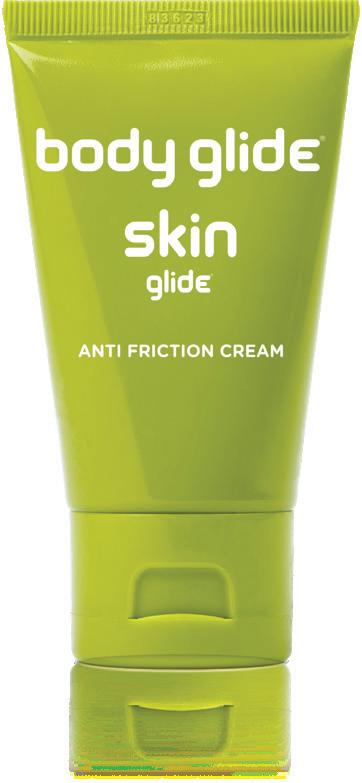
BEFORE MJ AND TIGER, before Bo Knows and Just Do It, before the Swoosh became one of the world’s most recognizable logos and Nike a global brand, there was Blue Ribbon Sports.
In 1964, former University of Oregon harrier Phil Knight and his collegiate coach, the legendary Bill Bowerman, established Blue Ribbon Sports. While Knight sold imported Japanese shoes out of his car, Bowerman experimented with his own footwear designs, including a waffle-like outsole, to ignite the upstart company’s own
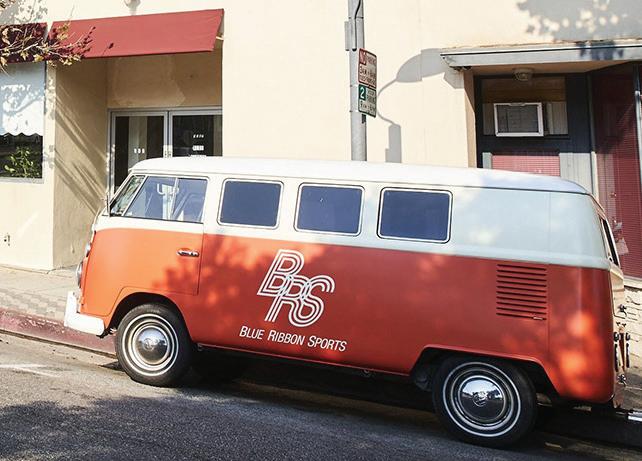
THE ATLANTA JournalConstitution Peachtree Road Race celebrated its 55th running on Independence Day with some 50,000 participants representing 32 countries and every state in the U.S.
The Atlanta-based event has grown from a 150-person race starting at a Sears parking lot into a staple of America’s racing calendar – and the world’s largest 10K. It boasts a decorated history that includes finish-line engagements, “virtual” Peachtrees at military bases around the world and holy water blessings at “Jesus Junction” in the city’s Buckhead neighborhood.

product line. The hustle and innovation spurred Blue Ribbon’s rise and laid the foundation for Nike’s corporate creation.
Over the six ensuing decades, Nike has embraced its Blue Ribbon history at various times, from a special Blue Ribbon Sports version of the Nike Cortez ’72 to releasing a comprehensive red, white and blue-colored running capsule in 2020 featuring an interlocking BRS logo.

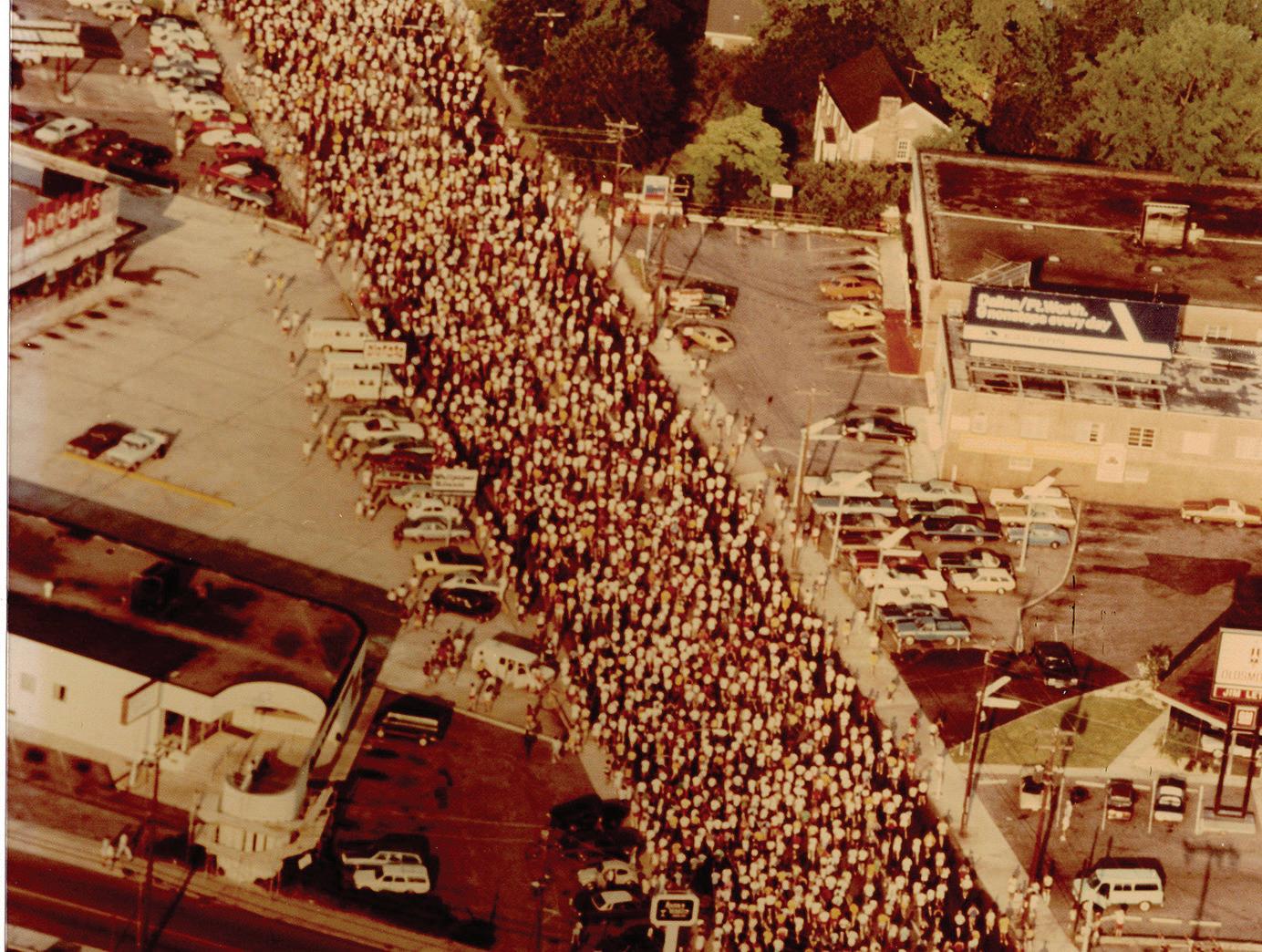
The 2024 edition of Peachtree honored the “Original 110,” the pioneers who completed the inaugural Peachtree on July 4, 1970. The Atlanta Track Club, the event’s organizer, also unveiled the Microsoft Peachtree Junior, a series of free one-mile races on July 3 offering youth the chance to cross the same Piedmont Park finish line as Peachtree 10K runners on the 4th of July.
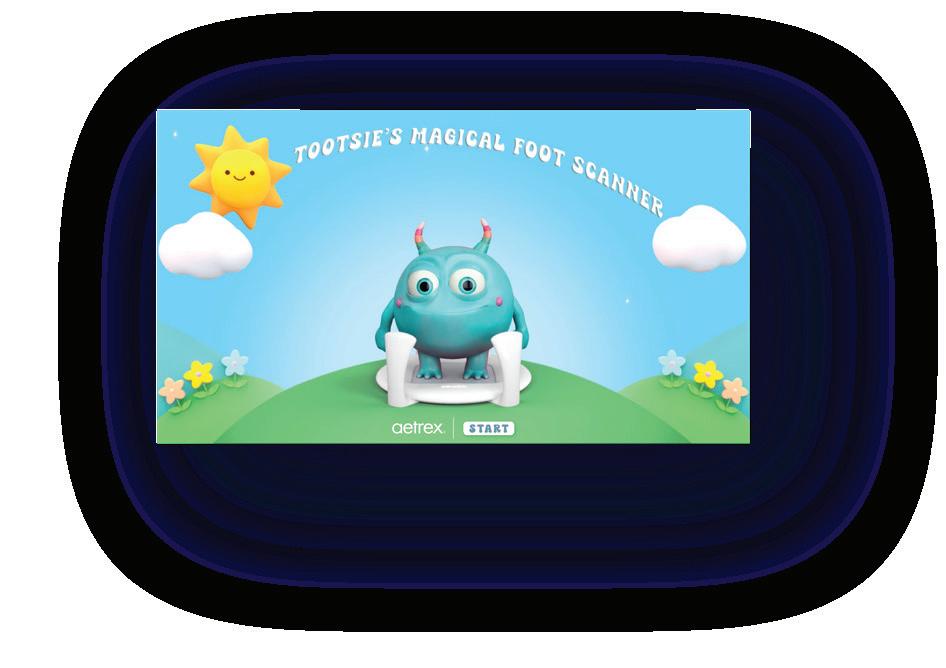
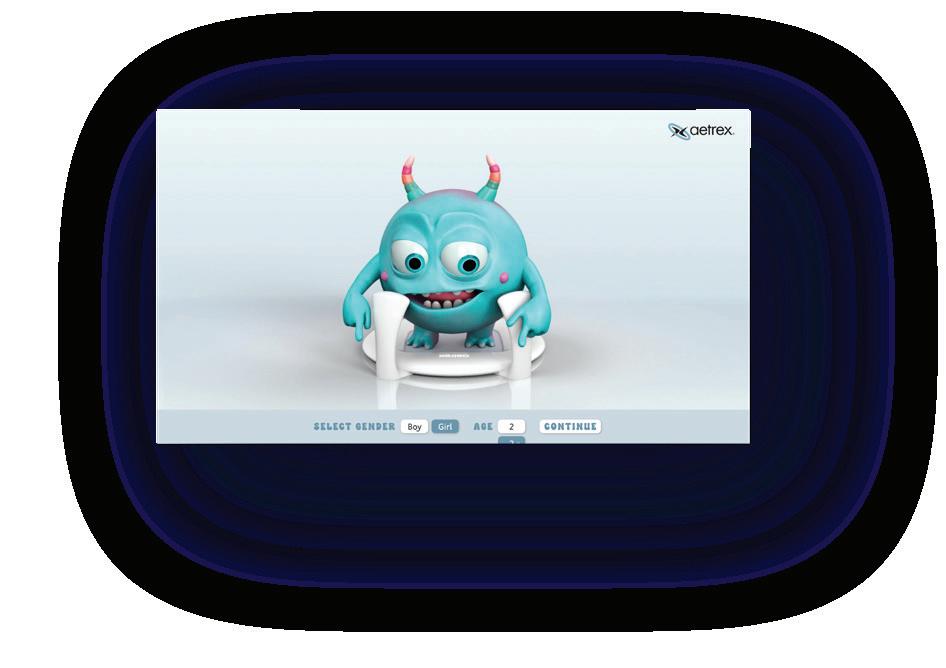
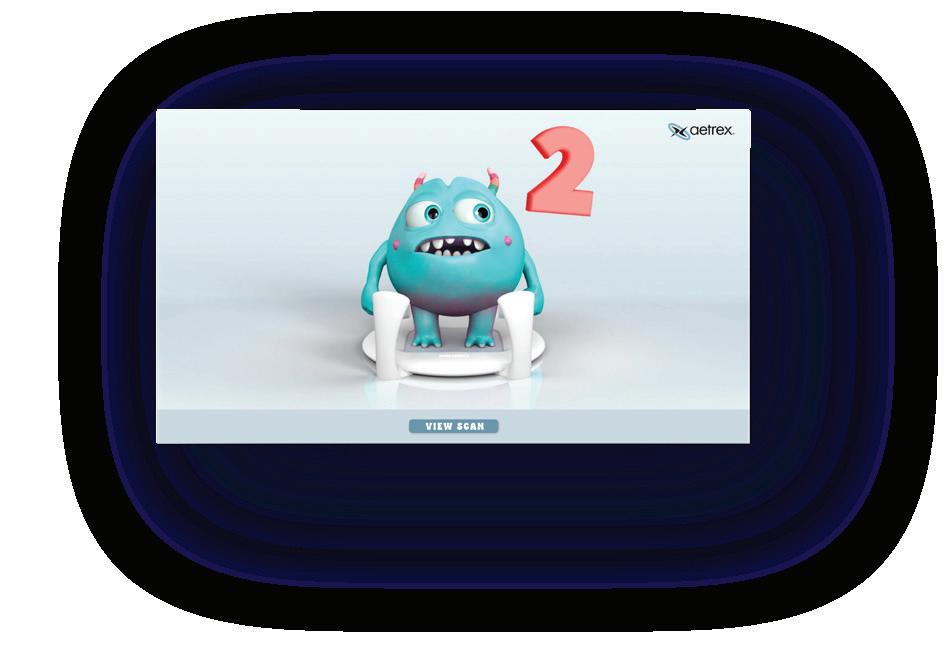

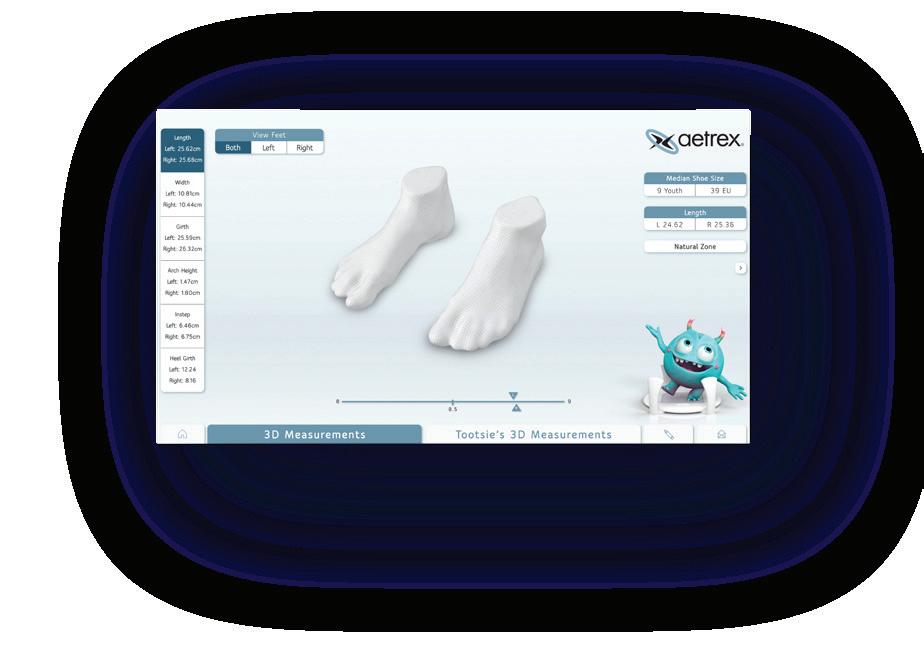



track spikes, a robust uniform business, school visits in its “shoemobiles” and a Team Bucks program that provides local coaches a credit based on athlete purchases made at Dick Pond’s five suburban Chicago retail stores.
But like many of running retail’s still-thriving pioneers, the company has evolved with the times to accommodate recreational runners and anyone else chasing a good pair of footwear and thoughtful insights.
DICK POND ATHLETICS BILLS itself as the nation’s oldest running store and its history – from 1972 correspondence between Dick Pond and Nike founder Phil Knight to old-school track spikes and singlets – is celebrated at its Carol Stream, IL, headquarters.
Since its founding, Dick Pond has embraced a focus on the athlete, a reality evident today in its massive selection of
WHILE BROOKS FOOTWEAR touched many sports and activities – ballet, baseball and roller skates among them – across its first six decades, running was ignored until the early 1970s when decorated American distance runner Marty Liquori connected with then-Brooks president Jerry Turner at an Atlanta trade show. Liquori would soon help Brooks bring a compelling footwear solution to market amid America’s running boom.
In 1974, Brooks unveiled its first
performance running shoe: the Villanova, a name inspired by Liquori’s college alma mater. The lightweight and flexible running
Glen Kamps, who has worked with the family-owned and operated business for 39 years, attributes the company’s 55-year run – and multiple Best Running Stores in America nods – to three core principles: a passion for people, a genuine commitment to making customers healthy and exceeding customers’ expectations time and time again.
“More attention. More advice. More energy. More than expected,” Kamps says.

shoe sported a mesh and nylon upper, a halfinch wedge in the heel and, in a reported first, a midsole comprised of a foam called ethylene vinyl acetate (EVA), an alternative to the heavier and less responsive midsole materials of the time. (EVA, of course, would become the go-to midsole in performance running shoes.)
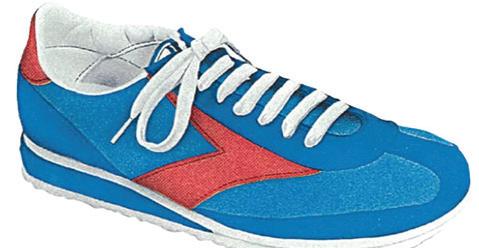
Two years later, the Villanova was an unquestionable hit. The model earned the runner-up spot in Runner’s World’s annual shoe ratings issue and successfully catapulted Brooks into the running universe.
FROM
and around the block, the Steamboat Classic has attracted elites and average Joes and Janes alike to central Illinois to participate in one of the world’s fastest four-mile races.
Founded in 1974 by Steve Shostrom with the backing of the Illinois Valley Striders, the Steamboat Classic is today run by ShaZam Racing, the racing arm of Peoria, IL-based retailer RC Outfitters.


FOUNTAIN VALLEY, CA. 1979. Dave Reynolds founds Loeschhorn’s for Runners, the first – and only – franchise of the upstart brand. When Loeschhorn’s decides to exit the retail game, Reynolds recreates his run specialty shop as A Snail’s Pace, a name inspired after Reynolds and his buddy slowed down to “a snail’s pace” on a run. The rest, as the story goes, is history. Reynolds would open additional stores across Orange County and steward the business alongside business partner Eddie Johnson.
Eleven years ago, Joe Lourenco, who began working at the store as a high schooler and pushed A Snail’s Pace into e-commerce and team sales, presented a 13-page report to Reynolds and Johnson during his annual review in an attempt to enter the store’s ownership ranks himself. It worked, and Lourenco is now the lone A Snail’s Pace owner following Johnson’s retirement. Lourenco has focused on operating a nimble business anticipating the needs of its customers and the marketplace. He’s


remodeling all four of his stores, starting with Brea this summer, as well as planning the debut of a new store – the first A Snail’s Pace to open in 20 years – by early 2025.
“Changing the way we run the business, whether it’s product mix, outreach or our fit process, helps keep us relevant with today’s runner,” Lourenco says.
FEET FIRST SPORTS IN COLUMBIA, MD, has endured a few evolutions since its founding in 1979, from various owners to varying product categories. Though initially dedicated to the runner, the store expanded to feature soccer in the 1990s and a hefty apparel assortment.
But these days, Feet First is undeniably running-focused with a hearty commitment to the locals.
“In addition to our awesome service and knowledgeable staff, one thing that we are proud of is that we are a community-centric store,” says Nakia Weable, who owns and operates the store with her husband, Brent Smith. “We love to partner with local businesses and non-profit organizations whenever we can. It strengthens our network and the ability to serve our customers beyond a fitting.”
The couple added a second location earlier this year when it acquired Tri Sport Junction in nearby Sykesville, MD, and subsequently rebranded it Feet First at the Junction.
IN HISTORIC downtown Bethlehem, PA, avid runner Chuck Kovacs opened Aardvark Sports Shop – so named to capture a spot at the front of the phonebook – in 1984. Four years later, Kovacs sold the shop to former Boston Marathon top 10 finisher Dick Haines.
From a staff of two at its launch to a team of 30 today, Aardvark has blossomed into one of the most successful single-door run specialty shops in the country under the direction of Dick Haines’ son, Bruce Haines, who purchased the business from his father in 1998.
Now in its fifth location, a 3000-square-foot spot on Main Street, Aardvark features a beloved mascot,

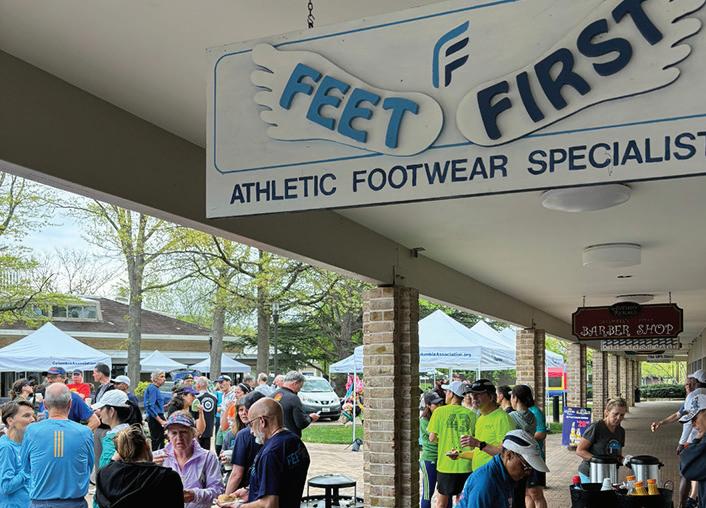

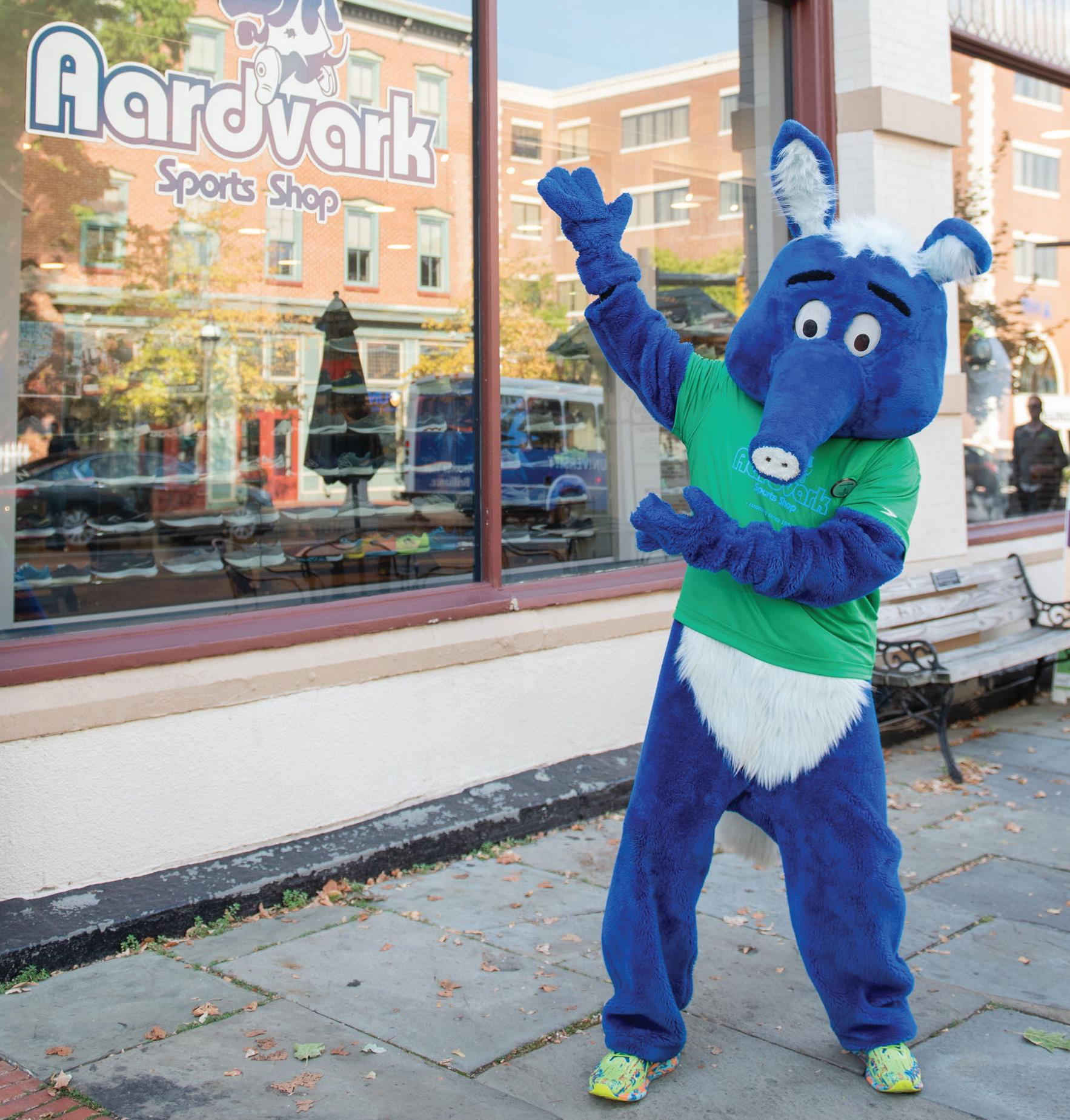
Aandy the Aardvark, boasts a lively group of ambassadors with its Team Vark training group and has earned multiple appearances on the annual Best Running Stores in America list.
“We never thought in our wildest dreams we would get to this point,” says Bruce Haines, who credits Aardvark’s ascent to “hiring good people, making an effort to make them feel valued and empowering them in a tangible way so that they feel a sense of ownership in the business’s success.”
After 30 years in the retail game, Haines is prepping for retirement at the end of 2024. Come January, Andy and Sheena Wells, a married couple on the Aardvark staff, will take the reins at Aardvark.
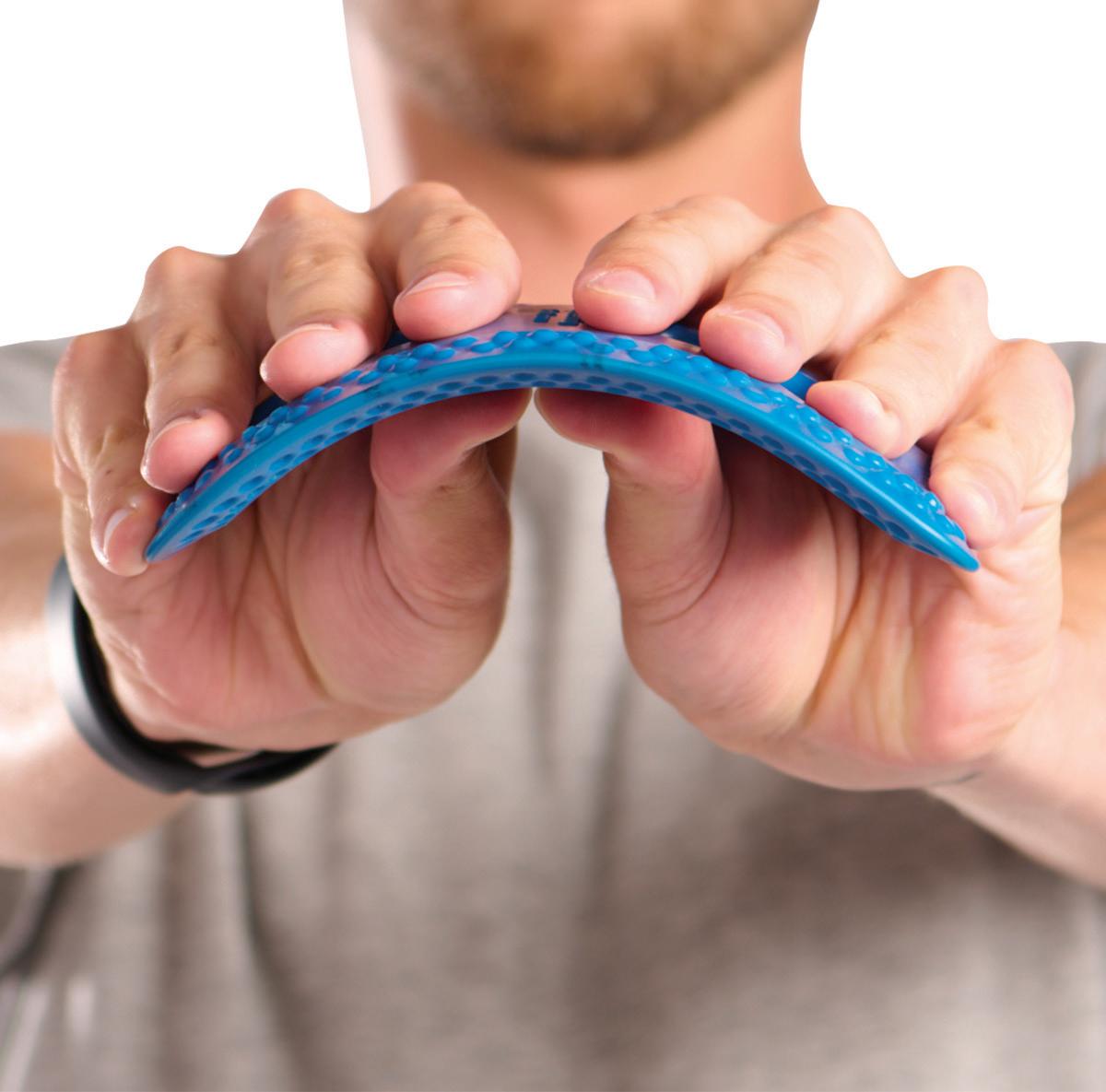


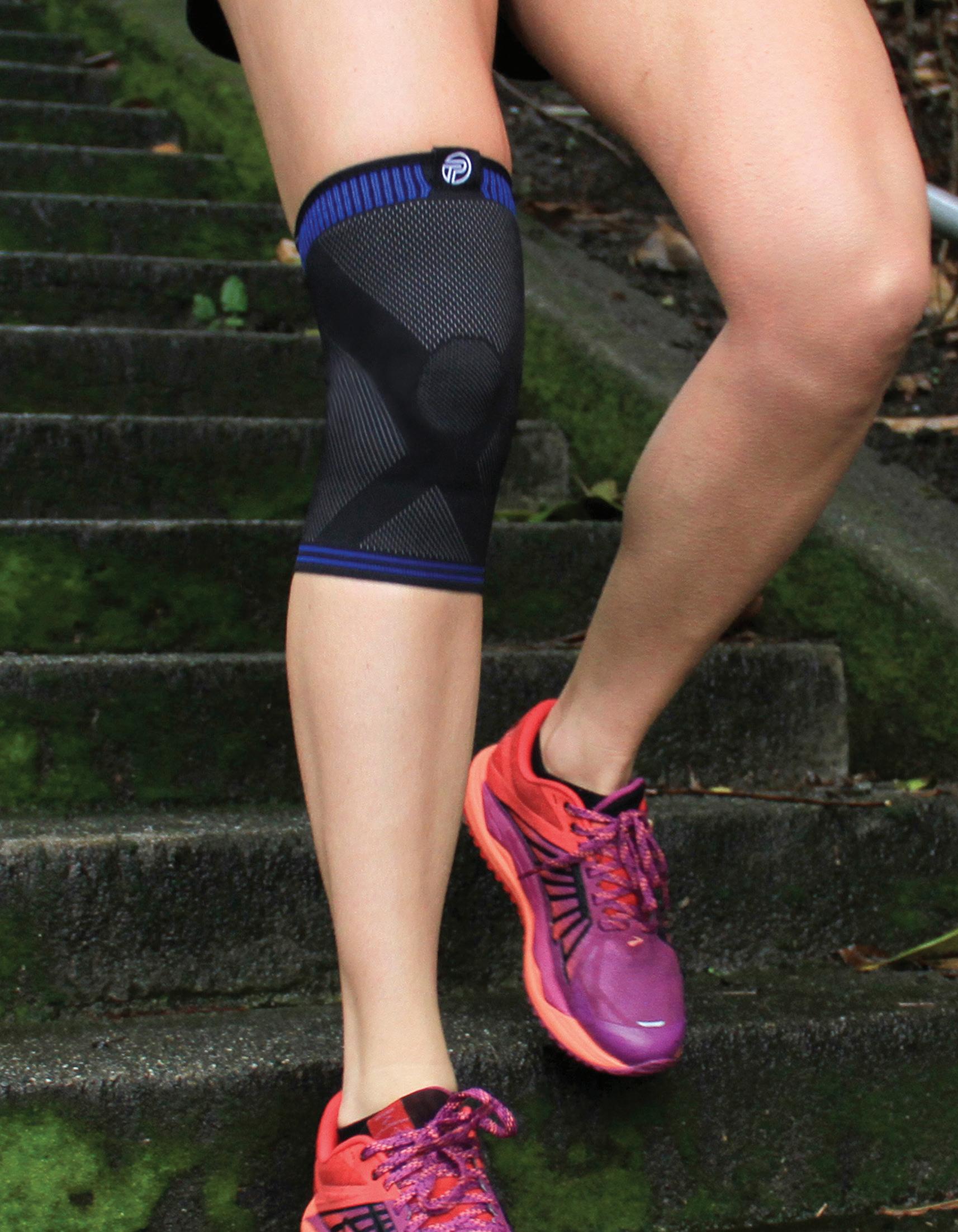


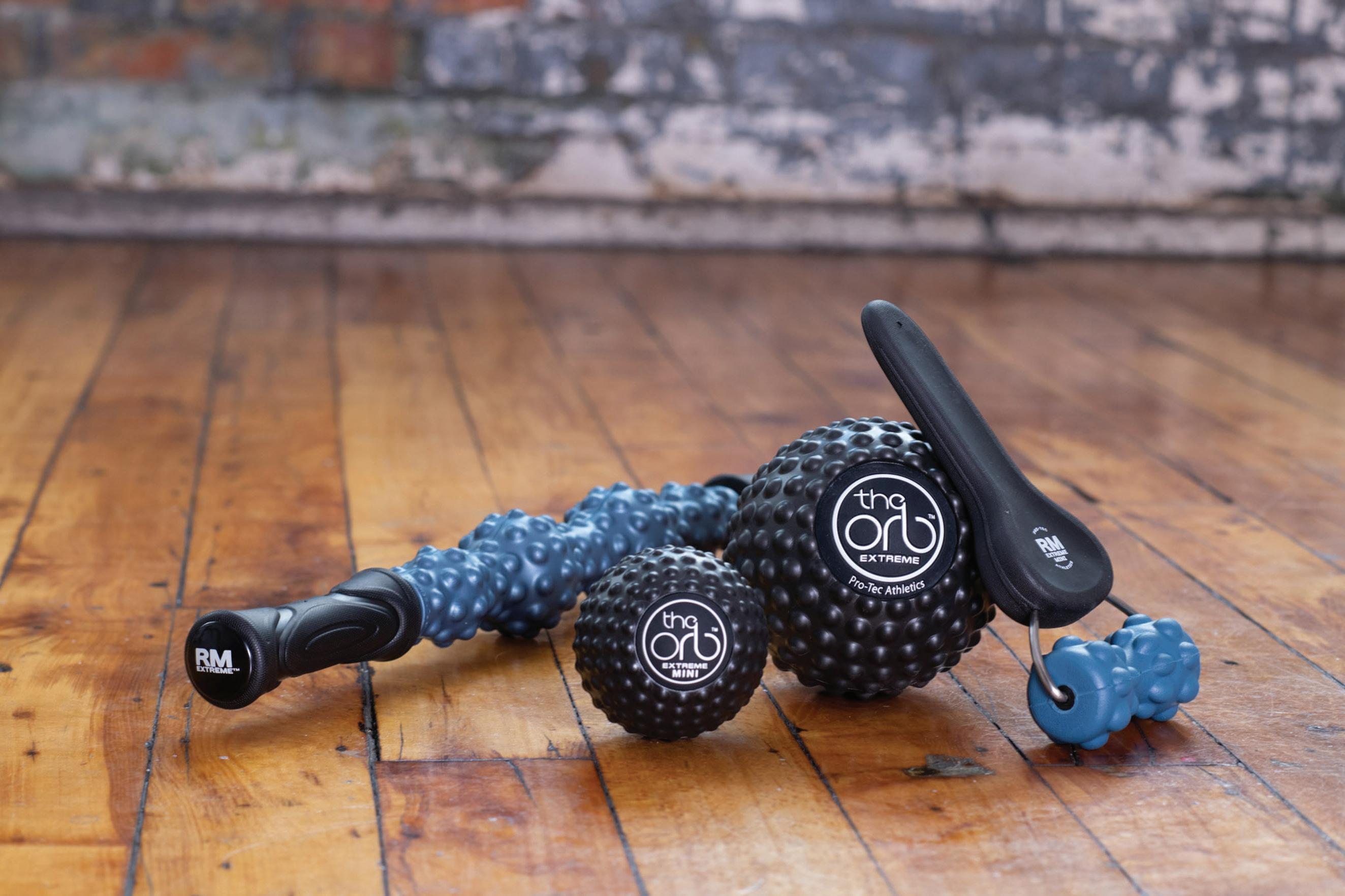

AT AGE 53, MORRIS MEDVED LEFT the men’s clothing industry in 1984 to branch out on his own, eager to combine his passion for running with his extensive retail experience. Today, Medved’s concoction – Medved Running & Walking Outfitters – is still cooking in Rochester, NY.
To be certain, Medved Running & Walking has changed from its original format.
Most notably, the store moved from its original 3000-squarefoot storefront – a massive footprint by 1980s standards for a run specialty shop – to its current 6000-square-foot shop in 2001 and saw an ownership shift to Morris Medved’s son, Dan. The store has also shed its manual ways, incorporating technology into its fitting process as well as inventory management, purchasing and bookkeeping operations.
“My father imparted lots of great advice to me over the years, none more true than the only constant in retailing and life is change. In order to survive you need to continue learning and trying new things,” says Dan Medved, the store’s second-generation owner.
But what hasn’t changed, according to Medved, is the shop’s culture and values, including treating staff, customers and vendors fairly and honestly.
“The commitment to excellence, the passion to help others, the desire to curate the best assortment possible and the belief that our customer relationships are long term … our longevity is a testament to that notion,” Medved says.




IN WASHINGTON D.C.’S ADAMS MORGAN neighborhood, the Fleet Feet shop on Columbia Road NW holds a particularly special spot in Fleet Feet lore. As the first Fleet Feet location outside of California, the Fleet Feet Adams Morgan store ignited Fleet Feet’s journey to becoming a national brand.
Originally opened by Phil and Jan Fenty in 1984, the couple’s son, Shawn, and his wife, Kim, assumed ownership 15 years ago and continue operating the store today, which earns Fleet Feet Adams Morgan another notable distinction: the first Fleet Feet location to achieve a transition from one generation to the next.




STEVE AND NANCY BOBENHOUSE INTRODUCED
Fitness Sports to the Des Moines, IA, running community in 1984 and it’s been a staple ever since, though one with a particularly lively recent history.
In 2021, Jordan and Lindsey Andrews, owners of two Heartland Soles stores in Iowa, purchased Fitness Sports and brought their two Heartland Soles stores under the Fitness Sports banner. Today, Fitness Sports has six retail locations – and just as many weekly group runs – scattered across Iowa as well as a commitment to putting “the customer first in all aspects of their fitness journey,” Jordan Andrews says.
“Fitness Sports is excited to be continually growing group runs and our racing team,” he adds. “Our goal is to continue to push the local communities together to meet other individuals, so everyone can help reach their fitness goals.”



DANIEL GREENHALGH REFLECTS UPON the last three decades with gratitude for Skinny Raven’s role as the epicenter of running culture in Anchorage.
“As we look upon this milestone, and the journey, I feel incredibly blessed that we’ve been able to be a part of so many lives
30

and stories,” says Greenhalgh, who began working at Skinny Raven as a part-timer in 1995, one year after its opening, before serving as the company’s CEO for 17 years and then purchasing the two-store business from Dana Manning in 2017. “I’ve filled every position from janitor to owner at some point or another.”
Of course, Greenhalgh’s head also spins when he considers Skinny Raven’s 30-year run. The highs. The lows. The challenges. The threats. The opportunities. A recession. A global pandemic. A pile of self-inflicted wounds. The particularities of running in Alaska, from limited daylight hours during the winter months to moose on the trail.
It’s really hard to do anything for 30 years – and even harder to do it well, Greenhalgh reminds. Yet, Skinny Raven has thrived by blending a focus on the collective – employees, customers, vendors and peers – with a short memory and an unrelenting mission to grow and improve.
“Skinny Raven has succeeded because we are always trying to be a better version of ourselves and that comes not only from the hands of every person who works for us today, but also the hundreds who have worked for us over the years,” Greenhalgh says. “They’ve all added their unique blend of special and that base of collective experience keeps us skipping, limping, sprinting, tripping and moving forward.”



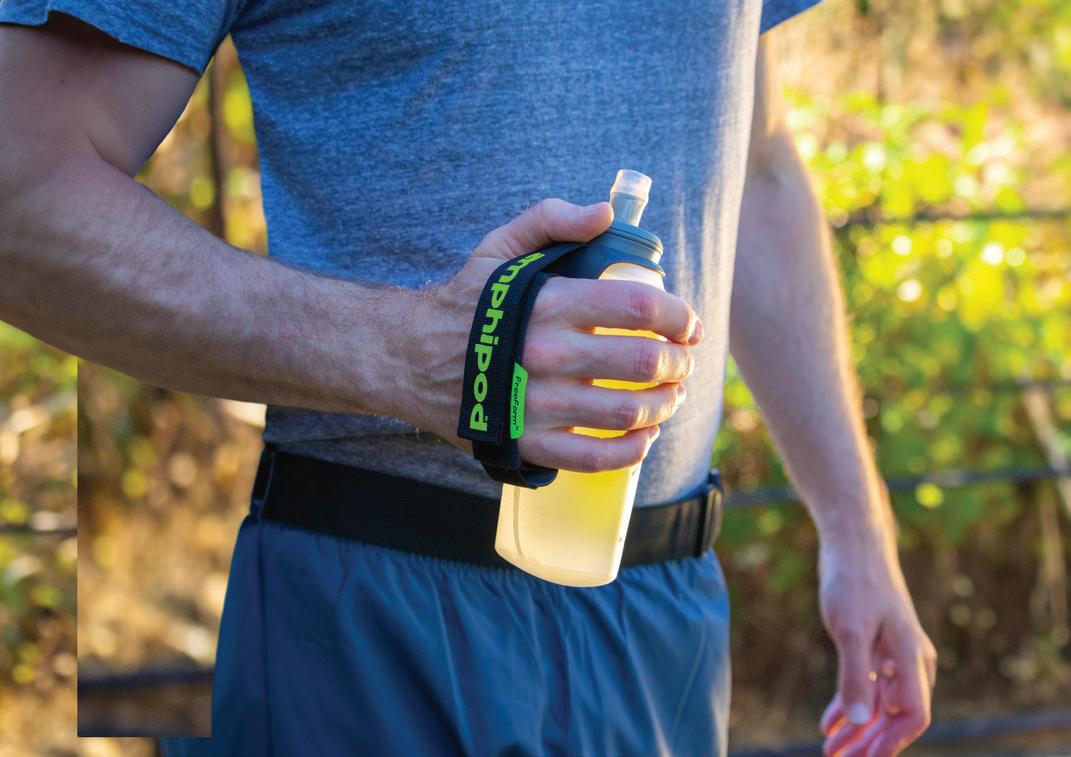

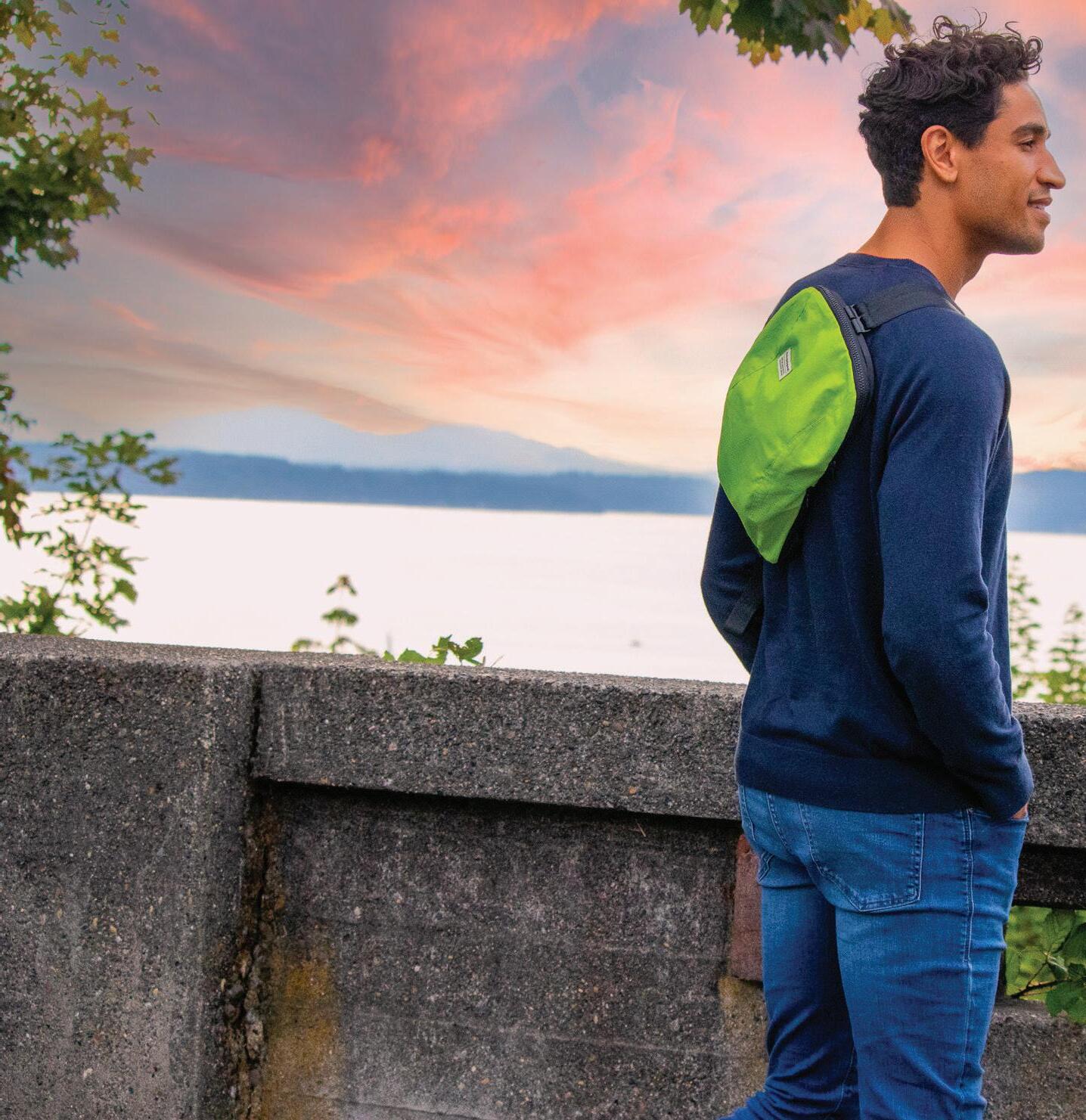
AS ORLANDO-BASED RUNNING RETAILER Track Shack developed more and more of its own events, store leaders Jon and Betsy Hughes founded the Track Shack Youth Foundation (TSYF) to power community giving.
Early on, the foundation supported efforts such as upgraded playground equipment and team uniforms. Over more recent decades, it has evolved to focus on consistent and ongoing programming across the local five-county school system. Today, TSYF features a grant application process overseen by a volunteer board of directors, an annual giving event, the annual Smile Mile youth run and a turnkey “running club in a box” for school and youth organizations wishing to start their own running program.
Over the last three decades, TSYF has sparked a passion for running and invited many youth into the sport, including World Championship medalists like mid-distance ace Jenny Simpson and sprinter Marvin Bracy-Williams.


THOUGH CONNECTICUT’S NEW HAVEN COUNTY claimed more than 800,000 residents back in the late 1990s, it lacked a running store, which frustrated local high school track coach Chris Dickerson.
“There was no place around us where I could say to my athletes, ‘Go there and get fitted for shoes,’” Dickerson says.
So, Dickerson took matters into his own hands and opened a run specialty shop himself. Since 1999, the Woodbridge Running Company has catered to thousands of runners, walkers and others from its 2000-square-foot home on Landin Street.
Dickerson describes his shop as a “blue-collar running store.” The showroom features old track spikes and running shoes as well as about 100 singlets from high schools, colleges and the professional ranks, including a Nike uniform once worn by Shalane Flanagan’s father, Steve. But the blue-collar isn’t just show; it’s baked into the store’s DNA.
“We’ve been through recessions, COVID, blizzards, running brands changing their inventory systems and plenty more,” Dickerson says. “We’ve always just kept powering forward.”
While Dickerson expanded with additional retail locations in Northampton, MA, and Brookfield, CT, he has since sold both


locations – to Marathon Sports in 2017 and the Ridgefield Running Company in 2024, respectively – to devote his entire energy to his Woodbridge flagship.
“And fortunately, business keeps getting better and better,” he says.

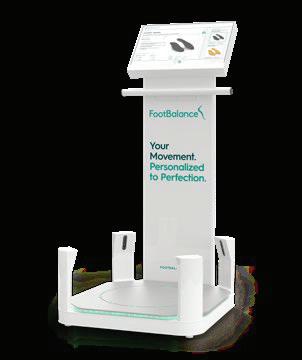

AT ITS MOST BASIC LEVEL, FLEET FEET LOUISVILLE is a retail store like hundreds of other retail stores scattered around Louisville. But really, it’s so much more, owner Erin Getz says.
Fleet Feet Louisville is an all-around community champion, hosting training programs and events, sponsoring races, partnering with other local business and driving philanthropy across Louisville.
“It is a privilege to serve and recognizing that is one of the reasons we continue to grow each year,” Getz says.
Fleet Feet Louisville is a two-time Best Running Store in America finalist (2022, 2023). It’s a lofty accomplishment Getz attributes to an ongoing process of staff development rooted in getting to know customers.
“We want our team to take pride in what they are doing because it’s more than just helping with footwear or insoles,” Getz says. “All it takes is one person to have an amazing experience with one of our outfitters and the word spreads like wildfire.”
After opening a second Louisville location in the city’s Fern Creek neighborhood earlier this year, Getz and her team are

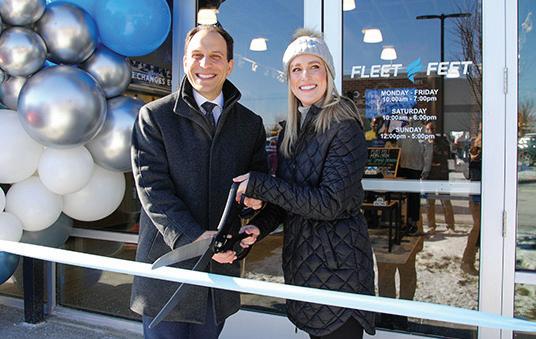
now preparing for another big event: the store’s 25th birthday celebration in August.
“We are looking forward to continuing to grow our reach in the Louisville area,” Getz says.
STEVE ROGUSKI LAUNCHED Fairhaven Runners & Walkers in 1999 and continues guiding the Bellingham, WA, running shop located in a historic 1890 building. He credits the store’s quarter-century run to five key factors:
1. Consistency. “Being grateful for and going all out for one customer at a time, time after time, year after year.”
2. A mission-oriented team. “Find great people, take good care of them, nurture a positive culture, have fun and respect and appreciate everyone’s contribution.”
3. Well-honed systems and procedures. “So that everyone knows what to do and how to excel.”
4. Mind the money. “Pay bills on time and look after finances.”
5. Embrace perspective. “Things go up and down. Know that. Relax and enjoy the fact that you are doing what you dreamed about.”


ARKANSAS’ OLDEST FAMILY-OWNED specialty running store, The Sporty Runner continues cooking in Conway – in a downtown spot that formerly served as a mule barn.
Founder Linda Starr says The Sporty Runner has reached the 25-year mark by continually meeting customers where they are at, whether that’s starting their fitness journey, chasing PRs, addressing a medical condition or simply looking for good, comfy shoes for the workday.
“By creating a welcoming, non-intimidating environment and showing we care about each customer’s needs, we have established a base of repeat customers who spread the word to their friends,” Starr says.


WHILE MIZUNO HAS CONSISTENTLY EVOLVED the Wave Creation since its pre-Millennium launch, the debut of Infinity Wave in 2007 with the Wave Creation 8 represented a major breakthrough.
Billed as a “mechanical midsole,” the Infinity Wave featured two Wave Plates running from the heel to the forefoot. The innovation reduced the “midsole sponge” and, according to Mizuno,

“substantially improved the cushioning, stability and resilience of Mizuno shoes and prevented them from easily running out of elasticity.”
In the 25th edition of the Wave Creation released earlier this year, the Infinity Wave remains; it’s a testament to the forwardthinking technology’s continued staying power.
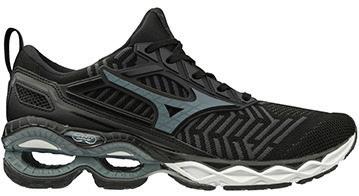
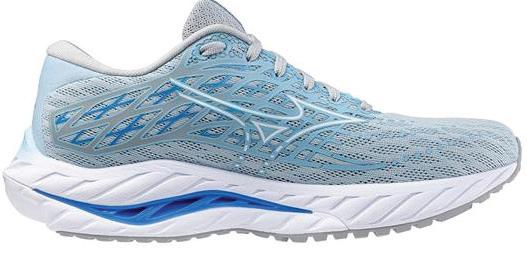
WHILE MIZUNO FOUND SUCCESS IN THE NEUTRAL footwear category in the early 2000s with its popular Wave Rider, making inroads in the stability arena proved more difficult. That is, until the Wave Inspire arrived.
For years, Mizuno engineers and designers had focused on making a firmer midsole to address pronation. Then, they switched gears and unlocked a winning solution. Drawing inspiration from the mechanics of vehicle acceleration and breaking, Mizuno shifted
NUUN, WHICH MEANS “SALT” IN SANSKRIT, burst onto the scene in the early 2000s with an undeniably unique hydration solution. The first company to separate electrolytes from carbohydrates in sports drinks, Nuun also provided an electrolyte tablet without the extra sugars and additives found in many mainstream products of the day.
Pro-product, pro-people and pro-planet, the little tablet that earned its credibility early on with ultramarathoners, triathletes and mountaineers. By the mid-2010s, Nuun was a fixture in many of the nation’s run specialty shops as well.
In July 2021, Nestlé Health Science acquired Nuun. The deal propelled the expansion of Nuun’s product offerings and accelerated its market penetration at retail outlets as well as its presence at events like the Twin Cities Marathon, California International Marathon and Marine Corps Marathon.

to a soft, smooth heel landing to reduce pronation. The fix found on the first Wave Inspire proved to be a game changer. The company’s SmoothRide innovation minimized the rapid acceleration and deceleration of the foot through the phases of the running gait cycle by reducing shock vibration and increasing flexibility.
The original Wave Inspire captured “Best Debut” honors from Runner’s World and immediately became a staple of the brand’s running shoe lineup.

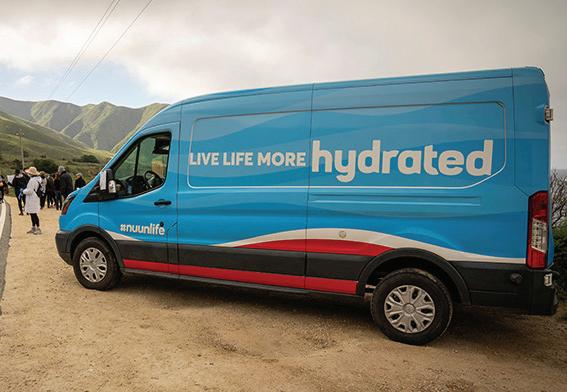
When suggesting insoles to your customers, consider these two industry-leading solutions. Whether your customer is pounding the pavement or walking the trails, retailers trust these two solutions to provide an insole for every need.
CURREX® RUNPRO® is designed for the highly active customer looking to enhance their performance. Available in 3 di erent arch profiles, providing a highly customized fit.

PowerStep® PULSE® is designed for the active customer needing arch support that allows them to stay active while alleviating from common foot conditions like plantar fasciitis.



PHILADELPHIA RUNNER OPENED IN 2005 to be a hub for the city’s running community, a place where people could meet for runs and learn about training, races, recovery, nutrition and more. Two decades later, mission accomplished, as Philadelphia Runner has played a leading role in City of Brotherly Love’s 21st century running boom. Once but a handful of local running groups, Philadelphia Runner owner Ross Martinson now counts more than 50. “We’ve been lucky to be a part of a vibrant, diverse and growing fitness community in Philadelphia,” Martinson says.
And Philadelphia Runner has grown, too, adding three additional stores, expanding its clientele far beyond runners, sharpening its attention to key business metrics and boosting its digital content.
“Just about every aspect of our operations will undergo some tweaks as we look to streamline and remove pain points,’ Martinson says.
To mark its 20th anniversary, Philadelphia Runner recently


OVER THE LAST TWO DECADES, RUN AWAY SHOES has become a layered venture in northeastern Wisconsin with two retail shops as well as an active event and timing operation. Owner Ross McDowell attributes the success to:


• An I-need-them-more-than-they-need-me philosophy: Whether it’s a customer, an event participant or a community partnership, McDowell says humility and staying connected and involved in the local running and walking world has been vital to Run Away’s growth.
• Making it personal: By living out their own passions for an active lifestyle, Run Away team members show customers the transformative nature of running, walking and fitness.
• Controlling its own effort: “So many people in this day and age get so uptight about their competitors and what Facebook says,” McDowell says. “We’ve learned to just relax and do the best we can and people will follow honesty, integrity and hard work.”
• Cultivating leaders: “Run Away is a bigger idea than me and it shows in the staff and how we’ve lasted so long,” McDowell says. In Colin McKean and Claire Koepp, for instance, McDowell has two capable, jack-of-all-trades leaders pushing the business forward in various ways.
• Persistence and resilience: “Twenty years in business provides plenty of opportunity for problem solving and overcoming obstacles,” McDowell says. “Success is not a linear path and we’ve grown stronger through navigating those obstacles as well as learning how to pivot.”
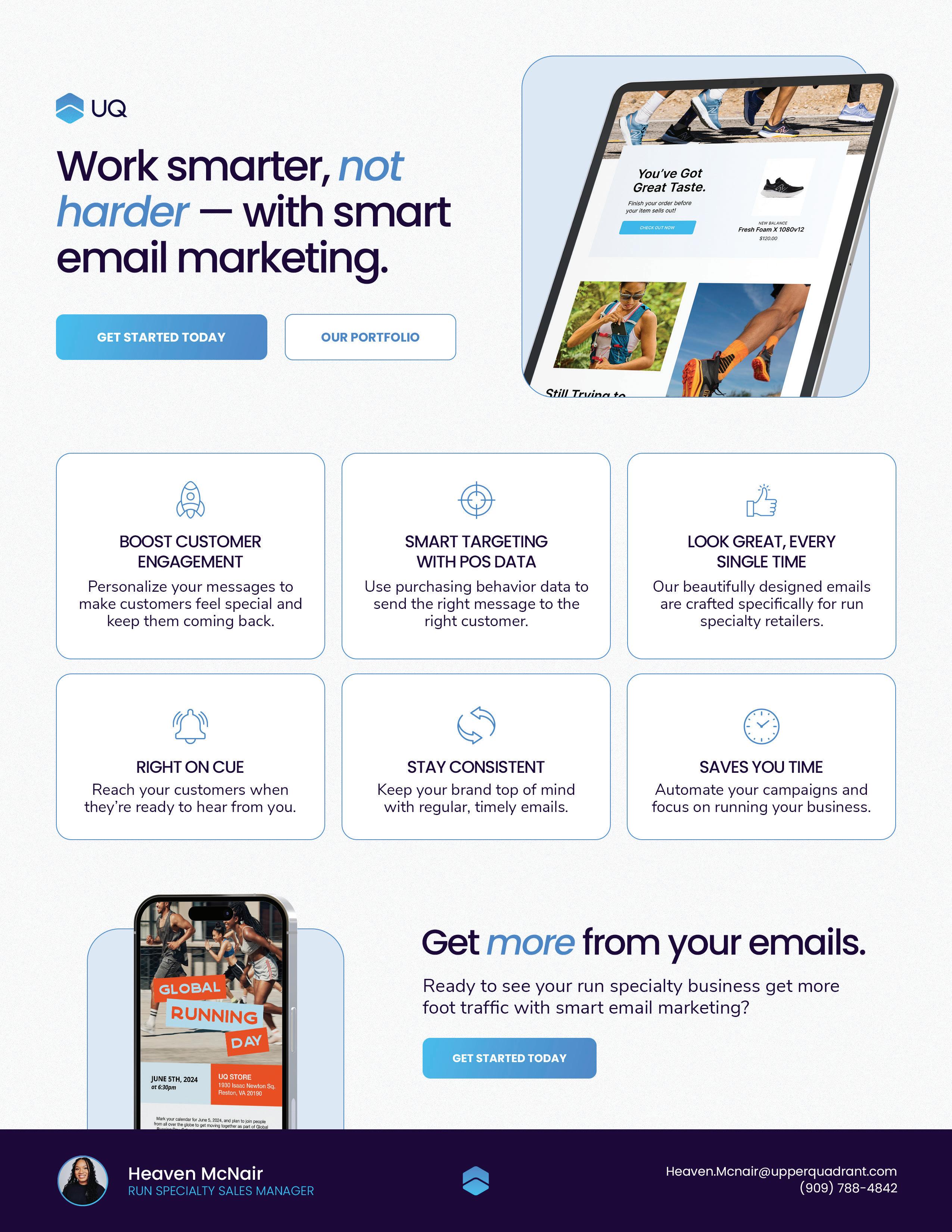
COLUMBUS RUNNING COMPANY OPENED in 2004 with a measly four footwear brands on its wall and dozens of balloons in its showroom to mask a largely barren space.
Those days, of course, are in the past for CRC, which now claims six stores in central Ohio as well as an event management company, a youth running club (The Grasshoppers), training programs, running clubs and a competitive racing team (CRC Elite) that has consistently placed members on the Olympic Marathon Trials starting line.
“Looking back at our evolution as a business, it’s gratifying to see how many more people we’ve been able to reach by going far beyond our retail walls,” says CRC co-founder Eric Fruth, who launched and continues to lead CRC alongside college crosscountry teammate Matt DeLeon.
CRC’s multi-pronged efforts to promote running and fitness helped it earn Best Running Store in America honors in 2014. But Fruth, DeLeon & Co. haven’t rested in the decade since winning that big-time honor.
“We still have a little bit of that chip on our shoulder,” Fruth says.

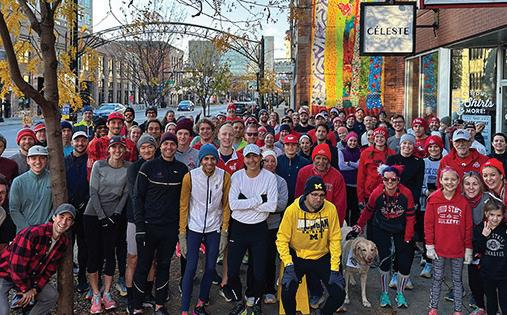
CRC recently unveiled a new website and a middle schoolfocused running club. There are also plans to expand the event management business, especially on the high school track side, and grow CRC’s retail partnership with the Nationwide Children’s Hospital Columbus Marathon and ASICS.
WITH PURPOSE AND INTENT, MIKE COSENTINO began crafting the business plan for Big Peach Running Co. on September 12, 2001, after an understandably cancelled flight and long car ride home to Atlanta.
Three years later, Big Peach was born.
Its 20-year run since is a testament to Cosentino’s energy and the devoted army that joined him along the way. There are now 12 Big Peach retail locations, the Big Peach On-Wheels mobile storefront, a screenprinting and embroidery sister business and a “Peach Partner” program unlocking opportunities for additional Big Peach storefronts.
Though Cosentino acknowledges “a long list of discontinued efforts and failed ideas,” he says the company’s “thoughtful evolution” over recent years has enabled it to build the necessary resources to impact local communities, steward its influence and reach its potential. And there’s more to come, Cosentino assures.
“We have some fun and big announcements coming as we blaze new paths and break new ground,” he beams.


Wicked dry. Wicked tough.
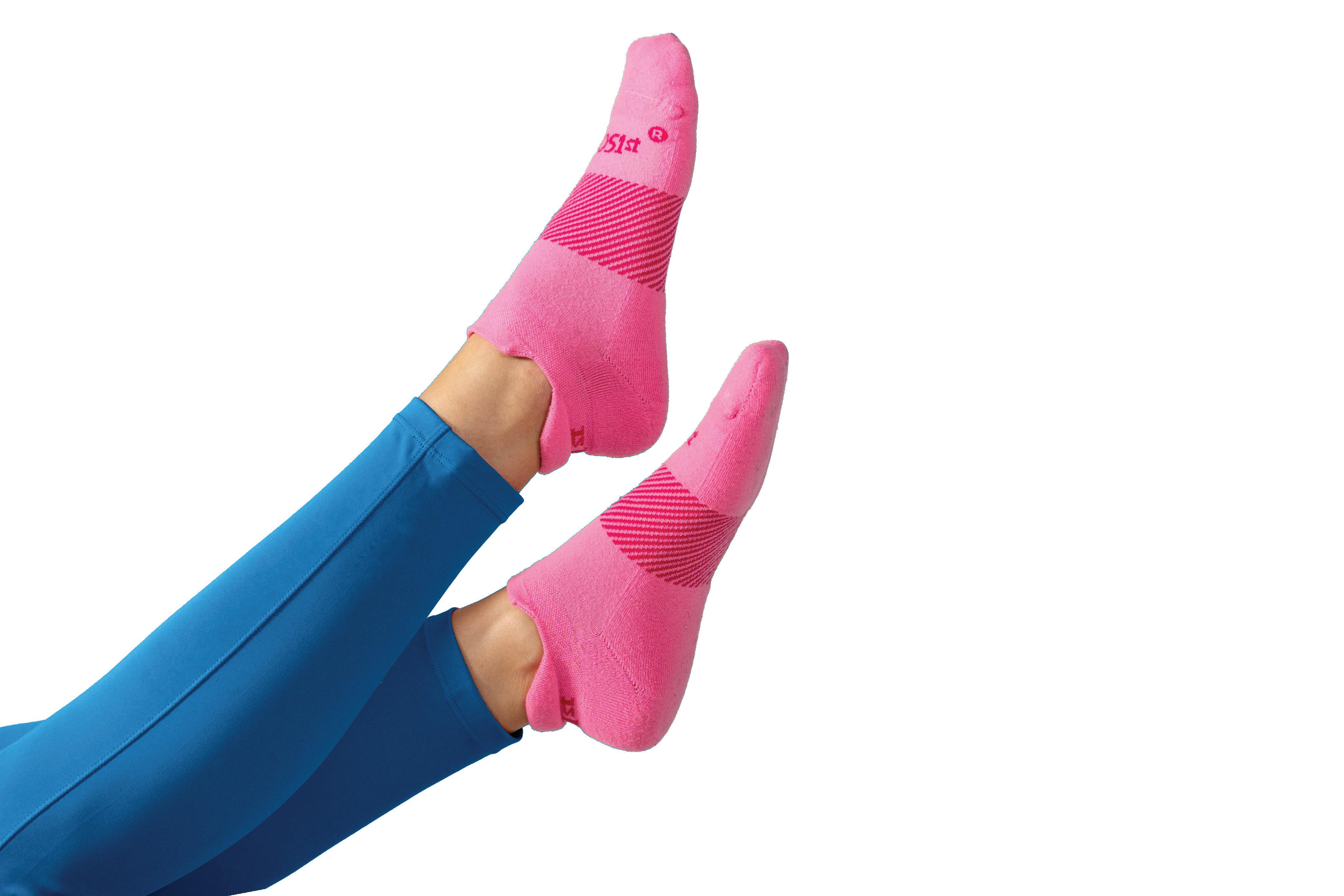

Max cushion
Ultra durable Comformance™ yarns
Moisture wicking
Dry 1st™ Technology
360 blister protection
BUY WICKED COMFORT NOW
THOUGH LIVING IN THE ROCKET CITY, Suzanne Swift reminds running retail isn’t rocket science. She abides by two foundational principles as the leader of Fleet Feet Huntsville in Alabama: Be flexible and serve the community first.
Carrying an unrelenting passion for running and an earnest commitment to her Huntsville home, Swift has spearheaded Fleet Feet Huntsville’s rise from one 2000-square-foot storefront in 2004 into two 6500-square-foot retail shops (Huntsville and Madison, AL), a roster of 50-plus employees, dozens of annual races and robust training programs that have pushed 7500 people to the finish lines of 5Ks, marathons, Ironman events and ultras.
“After 20 years, we are still finding new customers and making new walkers and runners in the community,” says Swift, whose family-owned business includes her sons, Alan and Skylor, and daughter-in-law, May.



BACK IN 2004, ALL ELLEN BRENNER and her husband, David “Boots” Boutillier, wanted was a running store. “It was just a simple plan to have a running shop,” Brenner says.
A simple plan, however, has turned into something quite massive.
Spurred by grit and hustle, Brenner and Boutillier have turned Fleet Feet Rochester into a thriving business with two retail stores – its Armory location, it’s worth noting, is a former Army Depot that held a shooting range, horses and vehicles – and a robust race management company. In fact, YellowJacket Racing owns and directs some 50 running and walking events each year and provides services for another 20 or so events in western New York.
While the couple’s business “tripod” of offering races, training and products is engrained in Fleet Feet Rochester’s DNA, they have adapted to changing times. New social media. Novel brands. Digital commerce. Revamping events or training programs to align with contemporary expectations. Malleability hasn’t been an option, but a necessity to keep pace with consumers.
“Very little remains the same and you must be able to adjust, adapt and improvise at a moment’s notice,” Brenner says. “Be married to the goal, not the plan because it can change at any time.”

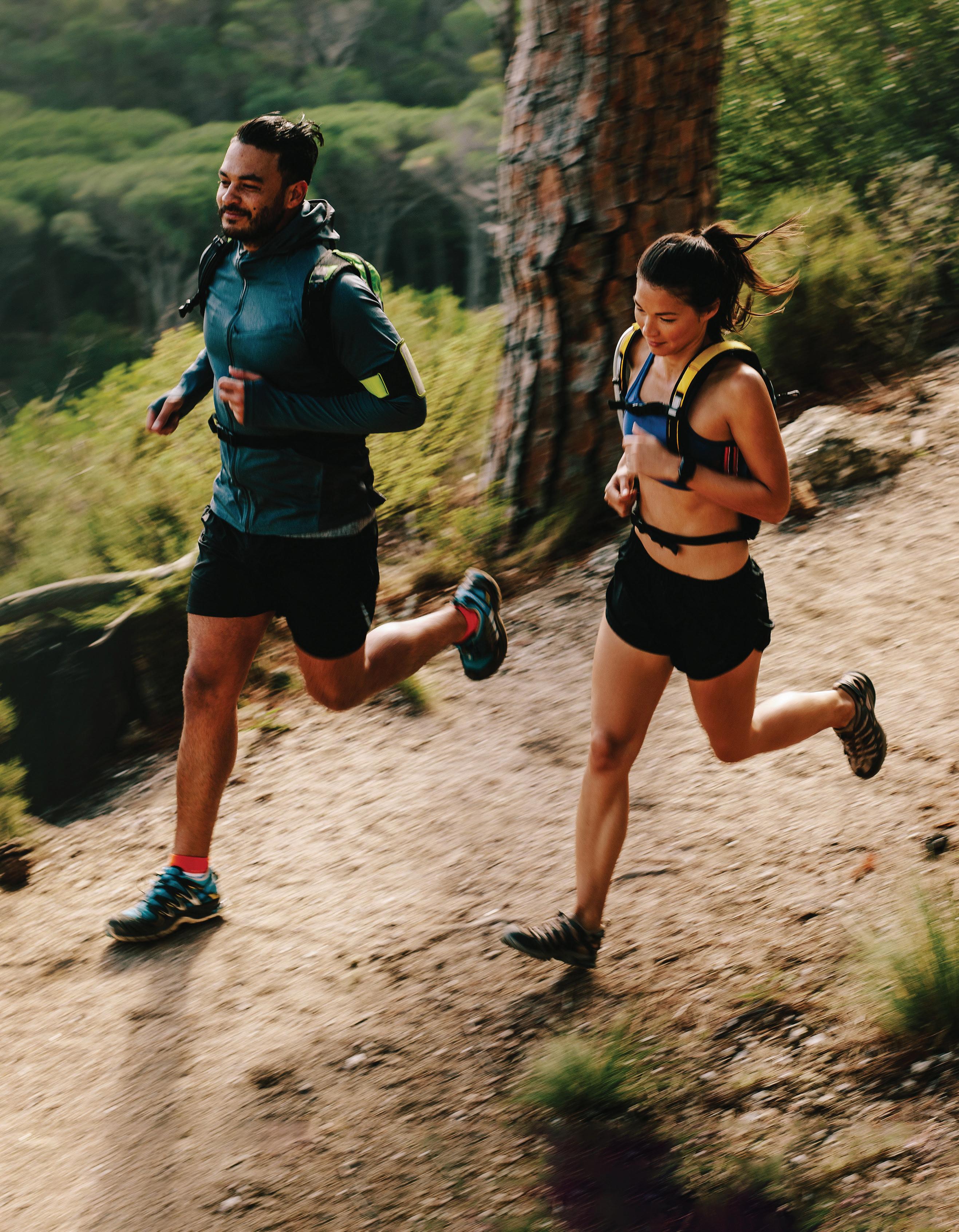

BEFORE FLEET FEET WEST READING in Pennsylvania, there was A Running Start. In 2004, Sorita Averill opened the run specialty shop in West Reading’s revitalized downtown and served as the store’s lone employee, working both the sales floor and the back office.
Oh, how times have changed.
For starters, A Running Start is no more. Averill became a Fleet Feet franchise in 2018.
Once housed in a leased 4000-square-foot space, Fleet Feet West Reading now inhabits its own building down the block from its original location. Two residential apartments on the property have been converted into additional retail space as well as offices, storage and a community room that provides learning, connection and inspiration by hosting events ranging from nutritional seminars to injury prevention workshops.
And Averill is no longer the retail shop’s lone ranger. Her team includes four full-time managers and 15 part-timers.
“Fleet Feet West Reading has embraced its identity as a ‘small but mighty’ presence on the main street, a testament to its commitment to innovation and community engagement,” Averill says.
PETER ASCIUTTO FOUNDED VAC & DASH in 2004 in downtown Albemarle, NC. As the name suggests, Asciutto peddled running gear and vacuum cleaners out of a 2000-square-foot storefront in downtown Albemarle.
Weird, of course. Wild, undoubtedly. Successful, well, oddly enough, yes, even as Asciutto pulled other businesses under his roof.
Over the years, Vac & Dash added UPS shipping, disc golf, bicycles, screenprinting and race timing services to its ledger, scoring year-over-year sales gains for its enterprising efforts.
Keeping with the quirkiness, the store’s April Fools’ Day 5k Classic literally ran through Asciutto’s home, while its annual Fellowship of the Idiot Run, a 19.7-mile winter jaunt from downtown Albemarle up to the peak of Morrow Mountain and back, earned finishers a spot on the retail store’s Wall of Idiots.
In 2022, Asciutto sold the multi-faceted retail operation to Jason Britney and his wife, Nicole Ashton, who rebranded the business Uwharrie Dash and sharpened its running focus.



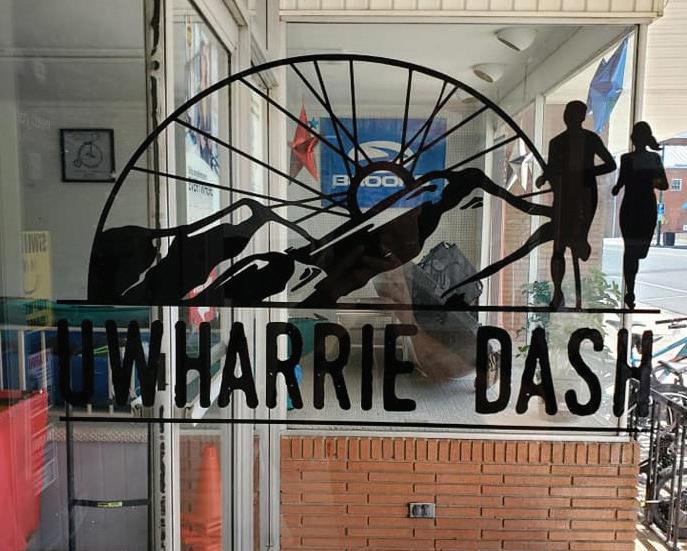
ADMITTEDLY, SOME THINGS HAVE CAUGHT Brad Altevogt by surprise since he opened Three Rivers Running in Fort Wayne, IN, 20 years ago.
He didn’t foresee his store’s retail footprint growing at such a mighty rate – from 1800 to 3600 to, now, 7000-square feet.
He didn’t expect Three Rivers Running – an homage to the three waterways slithering through Fort Wayne’s geography – to see its market reach extend so far across northeast Indiana and northwest Ohio.
He didn’t anticipate his customer base including so many non-runners.
And he didn’t see becoming so deeply involved in youth running. The store’s youth running program, Appleseeds, has blossomed from a summer program into a fall cross-country initiative, a winter break indoor track camp and a late winter/early spring indoor track program.
All pleasant surprises, though, that have propelled Three Rivers Running to its 20th birthday, a milestone it celebrated on March 9 with a high-octane party headlined by a performance from blues-rock artist Ally Venable.
So, the optimism is high that Three Rivers Running can continue its ascent and evolution under Altevogt and his daughter, general manager Lynn Marbach.
“We hope to remain an independent family-owned business for many years to come,” Altevogt says.
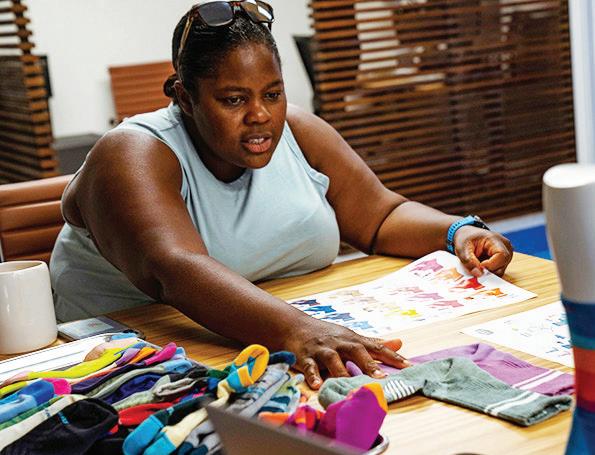



WHILE CABOT HOSIERY MILLS WAS FOUNDED in 1978, the familyowned, three-generation company’s fitness-oriented sock brand, Darn Tough Vermont, was created in 2004. Earning acclaim for its premium fit and Unconditional Lifetime Guarantee, Darn Tough can be found on the feet of runners, hikers, walkers, cyclists and a few celebrities, Sarah Jessica Parker and Jennifer Garner among them.
“We live under the mantra, ‘We have yet to produce our best sock,’’’ says Courtney Laggner, Darn Tough’s brand and community marketing manager. “What that looks like in reality is working hard every day to think bigger, work different and always be innovating.”
Darn Tough’s “Knit to Give” program, in which the brand creates unique designs with proceeds supporting a specific organization, has been a hallmark of the brand’s philanthropic spirit, too. Through the program, Darn Tough has donated more than 1.5 million meals to the Vermont Foodbank.


AS THE RUNNING MARKETPLACE was being bombarded with minimalist footwear in 2009, two men – Jean-Luc Diard and Nicolas Mermoud – weren’t afraid to stand out with something entirely new and different.
Enter Hoka One One. Born in the French Alps, Hoka intended to make long-distance running more forgiving with its freakishly high stack heights representing a counter to running footwear’s prevailing norms.
In 2010, Boulder Running Company, one of the nation’s most influential run specialty retailers, became the first U.S. running store to sell Hokas. In fact, the store ordered the majority of the Hoka Mafate’s first production run after BRC co-founder Johnny Halberstadt had a hunch the bulky, odd-looking show might help curtail injuries.
Early on, Hoka found success with the ultrarunning crowd, particularly after Karl Meltzer won a pair of 100-mile races in 2011 as the brand’s first U.S. athlete. And even though Outside famously labeled Hoka a “clown shoe,” albeit one that was “changing minimalist running,” Hoka continued gaining mainstream attention.
“When more athletes began reaching for Hoka, it was clear that our product was something special,” Hoka VP–global marketing Erika Gabrielli tells Running Insight. “The unconventional approach that our founders took certainly set the stage for consumers’ positive reception to our product.”
After Deckers fully acquired Hoka in 2013, it devoted resources and expertise to propel the upstart brand’s growth and visibility. Throughout the 2010s, Hoka
established itself a household name embraced by competitive athletes, thruhikers and everyday movers. It also pushed the running shoe pendulum toward “maximalism.” Things once different and eye-catching, the rocker profile and chunky midsoles among them, became commonplace across the performance running landscape.
Hoka, meanwhile, kept gaining steam and charging ahead. It diversified its product offerings, venturing beyond trail running to road running, track spikes, outdoor, lifestyle and apparel. Those extensions further elevated Hoka’s profile – and its sales. Last May, Hoka revealed revenue during its most recent fiscal year had climbed to $1.8 billion, a nearly 28 percent increase over the brand’s previous record-breaking tally.
OVER THE LAST 15 YEARS, the Healthy Kids Running Series (HKRS) has introduced a half-million kids in more than 500 communities across the U.S. to the sport of running in a fun environment designed to encourage an active, healthy lifestyle. Over the course of five weeks, kids run age-appropriate distances from a 50-yard dash for two-year-olds to a mile race for those in fourth grade.
“Exposing kids to a ‘race’ is a way for them to compete with themselves and improve on their experience week after week, while also helping them learn about winning and losing in a positive environment,” HKRS executive director Dawn Epstein says.
With a focus on inclusivity, HKRS offers a Challenger Division for children with special needs and/or disabilities, a Registration Assistance scholarship fund for families that may need financial support to participate and an Underserved Community program that brings HKRS races to areas with less access to healthy activity.
“Our mantra is ‘Get more kids running!’” Epstein says.
ORIGINALLY CALLED Run On! San Antonio – an offshoot of the Dallas-based running stores of the same name – founders Michele and Mitch Allen reinvented their three-year-old retail business as iRun Texas in 2012. The Allens then added two additional locations in 2012 and 2015, respectively, and became a staple on the Best Running Stores in America list.
Last year, the Allens sold the business to run specialty retail veteran Garrett Sage, who is working to build on the formidable foundation laid by the Allens while simultaneously putting his own spin on the operation. In his opening year, Sage added new footwear and apparel brands, hired dedicated marketing staff and solidified plans for a fourth iRun location in San Antonio.
“Michele and Mitch created great relationships in the industry and in San Antonio, so it’s exciting to step into that and grow the business by getting more people to experience what iRun Texas is all about,” Sage says.
15



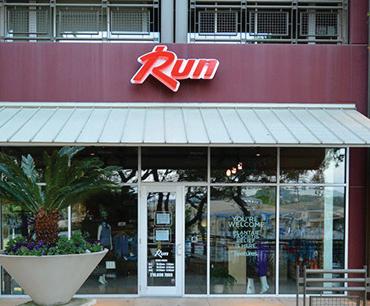
ONCE A SINGLE-STORE STAFF of four, the Fleet Feet Augusta, GA, crew now boasts 48 team members and, as of this summer, a second retail location in North Augusta, SC. Michael McCauley, who owns the operation with his wife, Jenafer, credits the operation’s significant growth to a high-quality, committed team and the steady presence of ownership in the stores and the community.
“It’s more fun now that we are doing more business,” Michael McCauley jokes.




FIFTEEN WAS THE NUMBER OF THE DAY on June 15, 2024, at Get Fit in Amarillo, TX.
The run specialty shop opened at 10:15 a.m., provided its first 15 customers an anniversary goody bag, offered store specials every 15 minutes past the hour and gave away 15 pairs of shoes on the day to boot.
Featuring the number 15 prominently, of course, was all the plan, a clever way to mark Get Fit’s 15th birthday. Through its races, in-store events and a 5000-square-foot retail space packed with top running gear and a values-oriented team, the female-owned shop has helped fuel the rise of Amarillo’s running community.
“Hiring a great team at the store level has propelled our business to be the destination for all things running in our community,” Get Fit owner Karen Roberts says. “I am proud of my team and their dedication and buy-in to my initial beliefs that we can make a difference in people’s lives by helping them choose the correct footwear, apparel and accessories as well as encouraging them to set and achieve their goals.”
It’s unlocked opportunities Roberts never saw coming, including the possibility of opening a second store. “People will always crave great shoes and comfortable apparel and Get Fit would like to be that destination far into the future,” Roberts says.
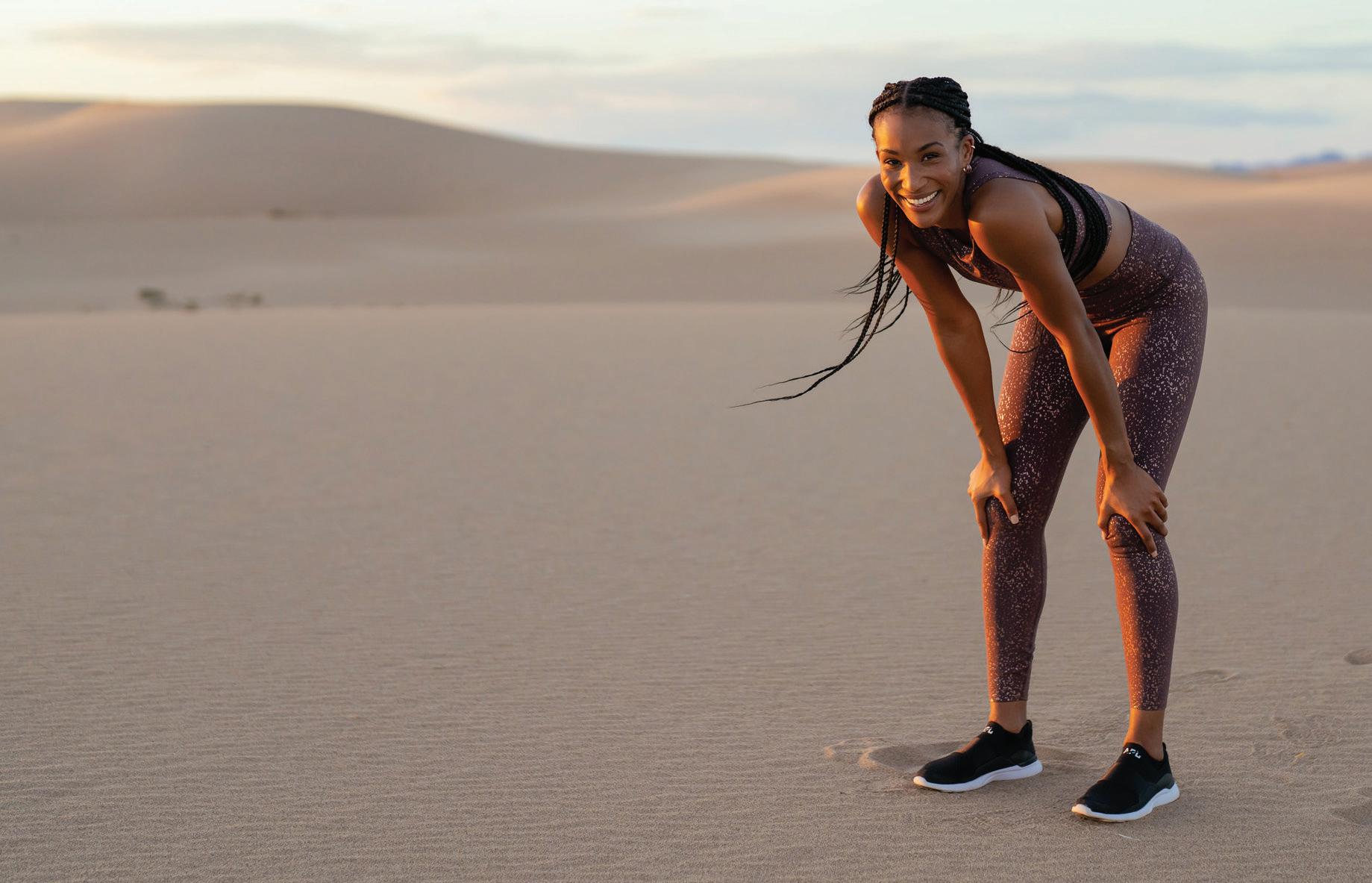


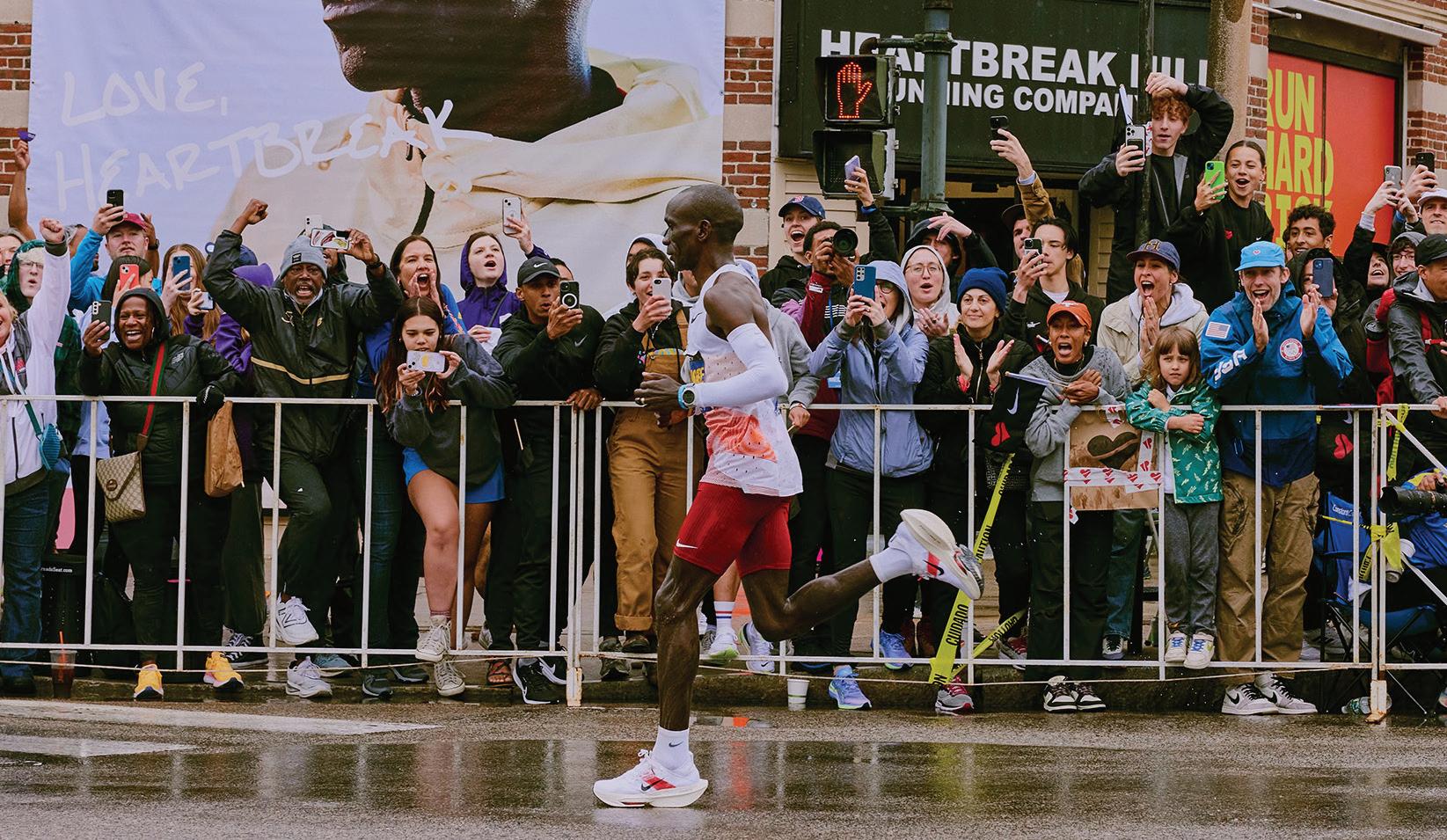
WITH HEARTBREAK HILL RUNNING COMPANY, former Boston College harriers Dan Fitzgerald and Justin Burdon have built a hip, four-store, two-city running retail enterprise.
Opened as the South End Athletic Company in 2009 in Boston, Fitzgerald and Burdon adopted the name Heartbreak with the debut of their second Boston store in 2011. After opening a third Boston area store in 2013, Fitzgerald and Burdon introduced a Chicago location in 2019. In the years since, Heartbreak has launched an in-house performance running apparel line and, in a particularly ambitious turn, introduced its own national NIL (name, image, likeness) program for college athletes called the Love Squad.
“We built a powerful brand that means something to the running community well beyond where we started in Boston,” Fitzgerald says. “We developed and cultivated community and brand together as we built the business and those are the two
things we continue to focus on.”
Heartbreak’s mission has never been pushing products or increasing basket size at checkout, Fitzgerald notes, but rather inspiring people’s running journeys with storytelling, programming and services delivered in person locally and across the country digitally.
“Going to D1 outdoor nationals, holding down Boston and Chicago with the highest touch in-person programming [and] tapping a Harvard jumper to commission and create music for our spring line all speak to what we do,” Fitzgerald says. “We make decisions based on what feels fun and what people who run will love.”
Capitalized to take its next big steps, Fitzgerald says Heartbreak plans to continue growing its apparel brand into new categories while also evaluating new cities for Heartbreak hub opportunities.


WITH THE MINIMALIST SHOE REVOLUTION at its apex in 2009, Saucony unveiled a lightweight, flexible performance running shoe combining a track spike-like upper, durable, responsive cushioning and a rare-to-find 4-millimeter drop. The $90 ProGrid Kinvara was an immediate hit. It gained a legion of fans, particularly among the high school harrier crowd wooed by its fast feel, lively colorways and economical price point, and captured lofty honors, including Outside’s Gear of the Year award in 2010.
YES, THIS VERY MAGAZINE HITS A MILESTONE anniversary in 2024. Fifteen years ago, Formula4 Media, the group behind The Running Event, published the first issue of Running Insight on January 15, 2009. The debut 12-page digital issue featured a few scattered advertisements, an outlook on the 2009 running landscape and thoughts on how local run shops might differentiate their business. Over the years, Running Insight has grown in size and sophistication, forecasting trends, sharing perspectives and ideas from the frontlines, introducing products and profiling industry movers and shakers.
For its first decade, Run Specialty Hall of Famer Mark Sullivan steered the editorial direction of Running Insight. Today, that task falls to Michael Jacobsen, who has been the magazine’s editor since 2019 following its acquisition by current TRE owner Diversified Communications.
While so many other running shoe models have come and gone since 2009, both at Saucony and other brands, the Kinvara remains a staple on many run specialty store shoe walls – a value-laden favorite that has evolved with the times while maintaining its speedy, yet soft DNA. The Kinvara 15, which launched earlier this year at the $120 mark, is a fast, flexible and straightforward workhorse featuring PWRRUN cushioning and recycled materials.


THOUGH UNDER ARMOUR HAD BECOME a household brand name by 2009, it did so by riding the wave of its premium athletic apparel. That changed when the Baltimore-based company unveiled its first performance running shoe: the Illusion. Thereafter, Under Armour released three additional road models and two trail options to bolster its first performance running footwear collection.
Under Armour’s persistence, brand equity and innovative mindset have helped it gain inroads in the run specialty marketplace, especially over recent years. Technology like HOVR+, Flow and Warp 2.0 have spawned appealing, competitive products and elite athlete performances by the likes of Sharon Lokedi, Weini Kelati and others from the UA Mission Run Teams in Baltimore and Flagstaff, AZ, have delivered unmistakable street cred to the brand.
“We’ll continue to innovate within run footwear, leveraging our strong pipeline of brand innovation and validating with our growing professional teams,” promises Jonathan Hutnyan, senior product line manager of Run & Train Footwear at Under Armour.


TIFFANY CRUICKSHANK LEARNED two quick lessons after launching her first Peak Running location in the Chicago suburb of Downers Grove a decade ago.
First, it takes more than just a deep passion and love for something to start a business and gain a foothold in the community. And two, that getting resourceful, creative and reading everything possible about running products, technology and mechanics would be central to her success in the competitive run specialty marketplace.
Taken to heart, those lessons have powered Peak’s evolution.
Struggling to land mainstream running footwear brands when she first opened, Cruickshank placed a bet on small, up-andcoming brands like Hoka, Altra and On. She also doubled down on an uber-personalized
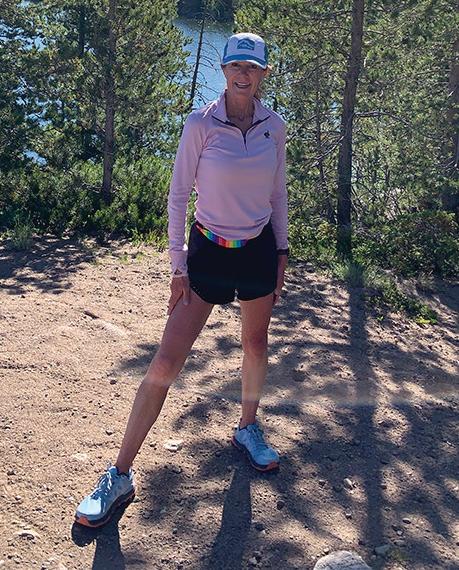

fitting process to ensure a true specialty experience. Those two ingredients combined with a committed and talented team and Cruickshank’s own entrepreneurial drive have created a two-state, five-store operation.
“It’s been an incredible journey from feeling like a ‘little girl in a man’s world,’” says Cruickshank, who continues exploring opportunities to open new locations, albeit with great care and thoughtfulness.
“Expanding the brand is thrilling and we’re dedicated to doing it in a way that sustains our values and commitment to our customers,” she says. “The run specialty world is always evolving, hustling, but being able to still have fun while doing so is where the magic happens for the team and our customers.”


When Lively Athletics first opened its doors in Oak Park, IL, co-founder Kate Marlin remembers “just praying” the store could stay open for one full year.
To be certain, Lively was taking the road less traveled as a women’s-only running shop bootstrapped by Marlin and her sister, Anne Pezalla. The sisters did the entire store buildout themselves, picked up their cash wrap from a shuttered retail shop, secured mannequins from a closed Sears store and displayed items on second-hand apparel racks. That Lively has made it 10 years is a “dream come true,” Marlin says.
“I could never have conceived of how much bigger it would become, and how many friendships would be formed, both with our awesome customers and with our employees,” Marlin adds.
From its founding as Lively Running in 2014, the store opened its lens and rebranded as Lively Athletics to be more encompassing. It brought in apparel, gear and accessories for other sports as well as casual clothing for daily, active life. It created a “Lively Littles” section stocked with youth footwear and a kids’ play space. And it experimented with popups like Lively in Guyville to serve male clientele.
“Now, it’s hard to remember the early days of that cavernous store with a few simple four-ways,” Marlin jokes.
Lively celebrated its 10-year anniversary in July with a flurry of fun activities, including free iced coffees, face painting for kids and tarot card readings as well as a special sip-and-shop event.
“Anne and I also joked about getting matching Lively logo tattoos if we made it to five years in business, so maybe it’s time I hold her feet to the fire on that one?” Marlin says of her sister.
AFTER MOVING FROM THE East Coast to Portland, OR, and working at run speciality shop Foot Traffic, Brett Farrell became increasingly enamored with trail running, particularly the personalities, camaraderie and lively culture he found blanketing trail races and events.
“So much of the marketing around running was about pain and discomfort and while that is certainly part of the running experience, I was finding something different when I hit the trails more often,” Farrell says.
That recognition spurred Farrell to create Territory Run Co., his whole-hearted attempt to put the beauty of running front and center.
At first a blog and one graphic tee, the Oregon-based brand now features an

OVER ITS DECADE IN BUSINESS, 605 Running Co. in Sioux Falls, SD, has encountered a building collapse, a car hurtling through its storefront, multiple stockroom floods and a robbery. And yet, here it stands, a thriving independent run shop and multi-time Best Running Stores in America honoree.
It’s a credit to the 605 team’s resilience, of course, as well as its single-minded focus on building a comprehensive running ecosystem that transcends traditional retail boundaries. In addition to two retail outlets providing premium products and personalized service, the 605 Running Co. orbit includes private coaching, nine local races that the company manages from start to finish, professional timing services and Zenith Endurance, the company’s post-collegiate race team.
“Running retail is such a niche market where trends shift, customer preferences evolve and new challenges arise all the time. As a small business in this climate, you’ve got to have the ability to pivot, innovate and adapt accordingly,” says Greg Koch, a former part-time employee at 605 Running Co. who bought into the shop’s ownership team in 2018.
To that point, the store recently debuted its membership-based 605 Run Crew, which offers exclusive benefits involving 605’s
10

impressive lineup of gear ranging from performance-oriented tops and shirts to socks, sweatshirts and hoodies. Territory’s caps, meanwhile, have earned a particularly cultish following among runners.
While Territory has largely been a direct-to-consumer brand since its founding, its products have wiggled into select run specialty shops over the years and Farrell says growing Territory’s wholesale business is his “next big push.”
“It’s time for us to expand and get into more shops and reach more people,” he says. “We’re still a small brand and there’s a huge market unaware of Territory.”


retail stores, running events and private coaching. Within its opening two months, the group surged past 50 members. 10
LONGMONT, CO-BASED SHOES & BREWS opened in 2014 as the nation’s first brewery/running store. The novel operation attracted the attention of national media, built a devoted following and found an even more symbiotic relationship between beer and running than its founders ever envisioned.
“The synergy between running and enjoying craft beer has created a unique experience that brings people together,” cofounder Ashlee Anderson says. “We’re humbled by the sense of community that has emerged and grateful for the connections we’ve made along the way.”
But the novelty alone hasn’t stirred Shoes & Brews’ success.
“Our employees are the face of our business and their interactions with our customers is the character of our business,” she says. “If it wasn’t for their dedication to providing exceptional customer service, we simply wouldn’t be around anymore.”
When looking to hire, in fact, Anderson embraces a long-held mantra in the hospitality space: hire for personality, train for skill.
“I can teach you everything you need to know about shoes and beer and how to sell them, but I can’t teach you how to like people — and people are our business,” she says. “Hearing their

IN HIS ORIGINAL BUSINESS PLAN, Steve Moore envisioned Run Moore as a “barbershop for runners” and while the Westminster, MD-based running store can turn into a gabfest about interval training, adventures on the trail and high school track memories, it has just as much become a place where people


concerns, making sure they have the right fit or the right drink. Our people love people and it shows.”

go “when they just need help from real people who actually know stuff,” Moore says.
“It actually makes me appreciate what we do way more than I originally thought,” he adds.
From being an early adopter of a foot scanner for fittings to an annually refreshed “Goal Wall” at the store and an active YouTube channel, Run Moore has cultivated trust and community with its patrons.
Moore now looks to build on Run Moore’s energy with a focused commitment to employee development. He’s already created a new full-time position for a seasoned part-time employee and aims to add another full-time position for an existing staff member by year’s end.
“Our staff are rockstars and we’re thrilled to be able to keep good talent with us and in run specialty,” says Moore, adding that his very first hire, Colleen Kernan, started with him as a high schooler and continues helping at Run Moore even after earning a master’s degree in public health and landing a full-time gig with the University of Maryland.


WHEN THE HUSBAND-AND-WIFE DUO of Cody and Janna Angell opened St. Pete Running Company in St. Petersburg, FL, in 2014, the couple initially feared they overextended themselves with their 2000-square-foot storefront.
“Boy, were we wrong,” Cody Angell laughs. “We’re busting at the seams.”
With a focus on providing “Wow!” moments, the Angells and their team focus on going above and beyond merely “good customer service.”
They’ve watched the six children of a marathon-training mom so she could get in a run, served as a donation site for fellow Floridians affected by Hurricane Ian and become a cooling place for locals in the aftermath of Hurricane Irma.
“We want to provide an authentic experience that demonstrates our empathy,” says Cody Angell, who directs most of the praise for the store’s ascent to his wife’s determined leadership. “Truthfully, we’d be totally screwed if [Janna] wasn’t here to do all the important things that have to get done.”
MEGAN SEARFOSS KNEW SHE HAD something special in her slice of Connecticut when Ridgefield Running Company employee Sophie Long donated part of her liver to customer Caitlin Balint.
“The Ridgefield Running Company community cares. They show up, teach and donate time to our causes of moving people forward,” Searfoss says.
Over the last decade, that earnest energy combined with Searfoss’s entrepreneurial spirit and an empowered team has pushed Ridgefield Running to do more and be more. There was the 2020 launch of a sister store in nearby Darien, CT – the Darien Running Company; incorporating iPads into the fitting and check-out processes amid the pandemic; and most recently, the acquisition of the Brookfield, CT, location of the Woodbridge Running Company, which has since rebranded to Brookfield Running Company.

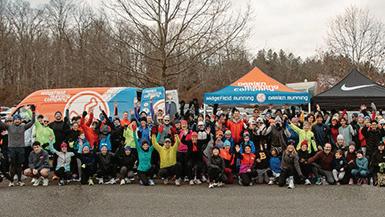
“They are game for always innovating,” Searfoss says of her squad. “They have flexed when we open a new store and are open
to sharing their opinions to make experiences better.”
It’s led to impressive results, too. At The Running Event in 2022, Ridgefield Running Company was named Store of the Year.
NICHOLAS STANKO AND IAN FORSYTH opened Ann Arbor Running Company (AARC) in the summer of 2014 on the steadfast belief that the “most successful run specialty shops are locally owned and operated.” And while Stanko and Forsyth didn’t think it would take much time to establish AARC as the college town’s go-to running resource, Stanko admits it remains an ongoing quest.
“I’ve learned that will probably never end and that’s okay,” he says. “New people are always moving into Ann Arbor and we need to be the place they land when looking for running gear and/or to become part of the local running community.”
Much like running, consistency is king and the blue-collar entrepreneurs continue putting in the work to elevate AARC, which now boasts three Ann Arbor locations – the flagship downtown storefront in addition to retail spots on the city’s north side and another on its south end. They remain hands-on leaders involved in everything from sales to purchasing to events and hunt for unique ways to differentiate AARC. Just recently, in fact, a physical therapist opened a gym geared toward runners on the second floor of AARC’s downtown location.
“So far, it’s gotten off to a great start and we think there’s a ton of potential for that relationship,” Stanko says.




JAMIE MASTROIANNI CAN’T HIDE HER excitement at iRun LOCAL hitting the 10-year mark in Saratoga Springs, NY.
“I’ve seen kids grow 10 years. I’ve seen people overcome obstacles physically and in their daily lives. I get to meet people from all walks of life and hear about their lives,” says Mastroianni, who concocted the idea for iRun LOCAL while training for the Philadelphia Marathon in 2012 alongside her husband, Anthony.
While Mastroianni once assumed her entrepreneurial success would be tied to sales and growth, she says the greatest joys sit
in helping to brighten someone’s day and leading a collaborative, dedicated staff.
“A winning culture doesn’t happen by accident,” Mastroianni says. “A team that works together, cares and upholds our mission and values takes work and accountability.”
After opening “off Broadway” in Saratoga Springs, iRun LOCAL moved to a spot twice the size in the heart of the city’s downtown in 2018. The store has also greatly expanded its product lineup and enhanced its digital footprint, including the rollout of a revamped, more user-friendly website.
BLENDING entrepreneurial instincts with a lifelong passion for running, former Yale University harrier Matt Taylor established Tracksmith as a brand for “the committed runner.”
Alongside premium materials, Taylor rolled in a sophisticated New England prep school aesthetic to counter the neons, heavy graphics and high-contrast apparel dominating much of the running market at the time. The name Tracksmith, meanwhile, highlighted both the brand’s unquestioned focus on dedicated runners as well as finely crafted product. (Fun fact: The characteristic red/white/red-striped tab found on Tracksmith apparel represents the lanes of a track.)
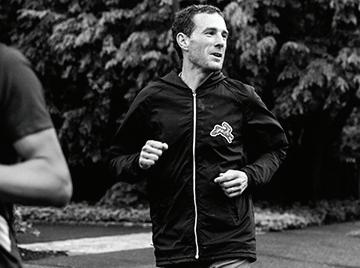
And much like a confident miler charging down the homestretch to the tape, Taylor and Tracksmith haven’t let up in their quest

to create a global running brand. They’ve unveiled pop-up shops in conjunction with all six marathon majors, opened retail stores in Boston, London and New York City, rolled out a branded mobile unit called The Envoy and entered the performance footwear space with The Eliot Runner. The Eliot Racer, a carbon-plated race shoe, will drop this year, too.
At The Running Event last year, Tracksmith also made its debut appearance on the exhibit hall floor. It was a sign that Tracksmith, which had only dipped its toes into the wholesale waters, was interested in deepening its ties to brick-and-mortar running stores.
“That’s new for us, though, and we’ll take it slow at the beginning to make sure we can be great partners,” Taylor says. “We’ll then expand and grow as we get our feet under us.”
THE ONLY ORGANIZATION
in the U.S. that unites the voices of outdoor enthusiasts to conserve public lands, the Outdoor Alliance has become a political force with a track record of success. Since its 2014 founding, Outdoor Alliance has helped protect 40 million acres of land, secured $5.1 billion in funding for public lands and waters and organized more than 100,000 people to directly advocate for better land, water and climate protection, management and funding.
Outdoor Alliance has also played a prominent role in pushing the bipartisan EXPLORE Act forward in Washington, D.C. The legislative


package, which passed the U.S. House in April, creates opportunities to improve how public lands are managed to enhance outdoor experiences for all.
“Our collective voices – motivated by a connection to the places we recreate – have made a true difference in protecting land, passing great policies and expanding sustainable access to the outdoors over the last 10 years,” Outdoor Alliance CEO Adam Cramer says. “We’re incredibly excited about what we can achieve working together in the next 10 years.”
WHEN NUTRITION researcher and runner Rafal Nazarewicz consistently encountered stomach and GI issues with existing nutritional products designed for endurance sports training and racing, he began cooking up his own recipes. Nazarewicz found success using real food ingredients such as rice and fruits and discovered friends liked his smoothie-like blends, too. That led Nazarewicz to team up with friend Adam Goleniewski to launch Spring Energy in 2014.
Over the last decade, San Francisco-based Spring has refined the packaging design of its flagship gels to feature tear-away tops with leashes, automated its production methods for greater efficiency and output and expanded its product and flavor lineup to include eight gel flavors, two meal pack flavors, two bar flavors and an electrolyte concentrate.

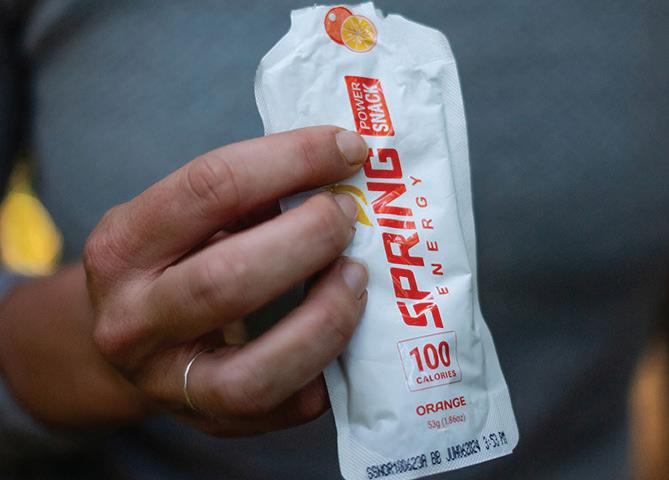
These notable running industry brands, retailers and players are also celebrating milestone anniversaries in 2024:
#40: Running Room
Canada’s powerhouse run specialty chain
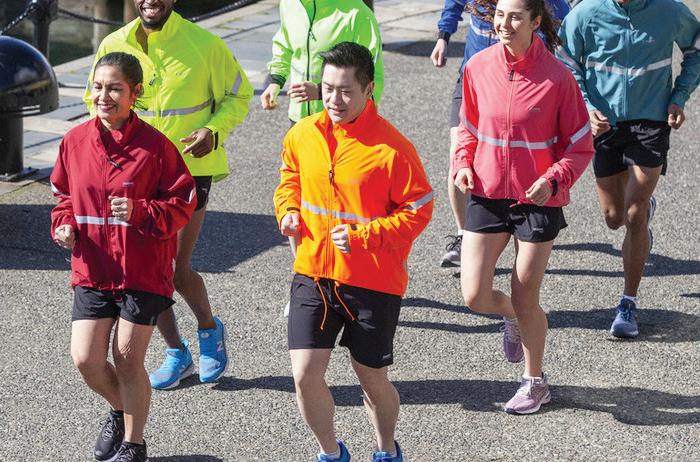
#40: Austin Jarrow
The OG running store in Duluth, MN
#35: Run For Your Life
Charlotte’s first run specialty shop
#25: Running Center
A Tampa, FL, run specialty staple
#20: Runners Lane
Run specialty in Santa Clarita, CA
#15: Fleet Feet Fox Valley
Running in Wisconsin since 2009
#15: Morgantown Running Co. Thriving near West Virginia University
#15: Believe in the Run
A top running product review site
From the team at Running Insight and The Running Event, congratulations to the Best Running Stores of 2024!
“These stores are managed by teams of people who care deeply about each other and their customers. This care and dedication creates ripple effects throughout communities across the country, not to mention all corners of the running industry.”
– Christina Henderson, Event Director, The Running Event

The Best Running Stores of 2024 will be celebrated at the 2024 Industry Awards Dinner, which takes place during The Running Event this November 21 in Austin, TX.
Produced by:

The 2024 Best Running Stores in America will be celebrated at TRE24 in Austin, TX in November.
Recognizing the best in the run specialty business, the 2024 Best Running Stores once again celebrates the retailers leading by example in the run specialty industry — the retailers that continually show their commitment to their customers and community. Leaders among their peers, these stores are always striving to create a stronger industry.
605 Running Company Sioux Falls, SD
A Runner’s Mind Burlingame, CA
A Snail’s Pace Running Shop Fountain Valley, CA
Aardvark Sports Shop Bethlehem, PAa
AKtive Soles Performance Footwear Wasilla, AL
Appalachian Running Company Camp Hill, PA
Big Peach Running Company Kennesaw, GA
Bull City Running Company Durham, NC
Charlotte Running Company Charlotte, NC
Charm City Run Annapolis, MD
Coastal Sole New Bern, NC
Columbus Running Company Grove City, OH
Confluence Running Johnson City, NY
Fleet Feet Carrboro & Durham Carrboro, NC
Fleet Feet Charleston Charleston, SC
Fleet Feet Fayetteville Fayetteville, NC
The winners of the 2024 Best Running Stores were announced earlier this month/ by Diversified Communications, organizers of The Running Event and the Best Running Stores.
The four finalists will be revealed later in the year and the 2024 ceremony celebrating all of the winners and announcing the Store of the Year will take place November 21 in Austin, TX, at #TRE24.
Fleet Feet Fort Wayne Fort Wayne, IN
Fleet Feet Fox Valley Appleton, WI
Fleet Feet Louisville Louisville, KY
Fleet Feet Montclair Montclair, NJ
Fleet Feet Nashville Brentwood, TN
Fleet Feet Northern New Jersey Summit, NJ
Fleet Feet West Reading West Reading, PA
Game Changers Running Co. Richmond Hill, GA
Gazelle Sports Grand Rapids, MI
Get Fit Amarillo, TX
Good Times Running Company Katy, TX
Grounded Running Beaufort, SC
Howe2Run Savannah, GA
iRun Texas San Antonio, TX
John’s Run/Walk Shop Lexington, KY
Mill City Running Minneapolis, MN
Naperville Running Company Naperville, IL
Pacers Running Washington, DC
Palmetto Running Company Hilton Head Island, SC
Performance Running Outfitters Brookfield, WI
Philadelphia Runner Philadelphia, PA
Playmakers Okemos, MI
Point 2 Running Company Newport News, VA
=PR= Run & Walk Ashburn, VA
Pro Bike + Run Monroeville, PA
RC Outfitters Peoria, IL
Red Coyote Running and Fitness Oklahoma City, OK
Ridgefield Running Company Darien, CT
Run Hub Northwest Eugene, OR
Run Moore Westminster, MD
RunAbout Sports Roanoke, VA
Runner’s Edge NY Farmingdale, NY

Runners Roost Lakewood Lakewood, CO
Running Etc. Virgnia Beach, VA
Running Lab Brighton, MI
Running Zone Melbourne, FL
RunWell Edwardsville, IL
Salt Lake Running Company Salt Lake City, UT
Sole Sports Running Zone Phoneix, AZ
Terra Running Company Cleveland, TN
The Runner’s Edge MT Missoula, MT
The Running Well Store Kansas City, MO
Tortoise & Hare Sports Glendale, AZ
Track Shack Orlando, FL
Up and Running in Dayton Dayton, OH
Waco Running Company Waco, TX
Whirlaway Sports Center Methuen, MA
These brands sent product to all Best Running Store honorees to help in the celebration.

Current technology in the run specialty landscape is a varied medley of stalwart and contemporary components. Your industry colleagues deploy a spectrum of scientific tools ranging from the trusty Brannock Device to fancy scanners that interpret, to a specific percentage, a foot’s degree of medial arch elongation. There’s some really cool stuff out there.
Given all the interesting ways we go about fitting folks for shoes, it’s interesting to note that the common thread of all these ingenious gadgets and gizmos is customer loyalty. This suggests that what drives customers back to your store transcends the sort of tech you deploy. Devoted customers subscribe to what you stand behind, which underlines the rationale behind plugging into technologies that genuinely enthuse you. Dare I say — it doesn’t matter what you use to successfully fit a customer. What’s important is that you believe in your bones exactly how you’ve chosen to do it.
It seems the decision to utilize certain technological options over others is commensurate with any kind of modern innovation. Some people are early adopters of anything newfangled, while others rely on those early adopters’ feedback before taking the plunge.
Some folks, however, stick to what they know and don’t stray, not too far anyhow, from their areas of comfort. Such inclinations, I might joke, are made evident by the sort of cell phone in your pocket. Do you have the newest model? Or one that’s a few iterations old? Or perhaps you’re still rocking a flip phone. Surely there’s a place for all of these options. The same goes with our industry’s mixed bag of fit technology.

Even with all of the retail tech available, run specialty retailers still often turn to the Brannock Device to maintain that personal touch that complements modern technology..
In their own words six different store representatives who operate a total of 34 brick-and-mortar doors provide their insight into how technology of all sorts is utilized in their businesses. They represent a geographical cross-section and give voice
to both the most seasoned and freshest fit philosophies, all of which include their take on the technological future of the run industry. Take a look at what your fellow fitters are doing while asking yourself, Where do I fit in?

ANN ARBOR RUNNING COMPANY
Three Locations in Ann Arbor, MI
Established in 2014
Mission Statement: We support the running community through thick and thin. We believe that having a locallyowned specialty running shop to lean on plays an important role in bringing people together. We use our experience and expertise to select the best products available in an effort to help runners navigate all the ups and down our beloved sport offers.
Fitting Tech Used: Brannock Device, Currex Foot Disc
Comments provided by Nicholas Stanko, Co-Owner
All employees go through our World Famous Shoe School staffed by instructors who have been working in run specialty for 20-plus years. Our trainers share their combined knowledge with new hires, who are then expected to graduate at the top of their class. We believe a successful fit happens when we provide the customer with relevant options and allow the customer to make the final decision.
The main piece of technology we use is a Brannock Device. Occasionally, if the customer wants to see what we’re seeing, we’ll utilize a Currex Foot Disc. But most of the time we just use the Brannock to take weighted measurements while the customer is standing.
Then we watch the customer walk barefoot and have them do
single leg squats in order to understand what their foot is doing while in motion. We also like to look at the customer’s old shoes and discuss wear patterns. All of this is conversational — we take the time to let the customer know what’s going on based on their foot structure and biomechanics.
We believe this amount of supplemental tech is enough. What’s most important is that our staff conducts a thorough interview, then uses the learned information to select shoes that are a good option.
We appreciate not being reliant on any modern technologies. We’ve looked at different options out there, but nothing seems to be the right fit for us. I guess you could call us old school, but we live by the belief that if it’s not broken, why fix it?
We are confident that our customers enjoy coming in to talk to our staff rather than interface with a computer.
Tech’s Future: The future is dependent on staff. Specifically, a great team of people who can naturally interact with customers and build honest relationships. We strive to provide all customers with the kind of service they can’t get anywhere else. We believe that if they trust us, they’ll come back.
Burlingame and San Francisco, CA
Established 2010
Mission Statement: Movement is Life
Fitting Tech Used: Brannock Device, Currex Foot Disc, Video Analysis, Homemade App
Comments provided by Eileen Urtz, General Manager
At A Runner’s Mind, our goal is to provide each guest with all the necessary resources to work towards their goals. We believe a successful fit is one that leaves them with a full understanding of how they move. Of course we love if they make a purchase, but if we’re fitting according to our motto, a purchase isn’t always necessary. We’re just as happy to offer information. We want every interaction to prove we are a one stop shop for all of our guests’ running and walking needs.
Technology definitely plays a role, but more important is the one-on-one relationship. No matter what tech we have, it will always be secondary to human connection.
Our fitting process is a combination of old-school methods mixed with modern technology.
We measure everyone’s feet with the Brannock Device, then have guests stand on a heat and pressure-sensitive Currex Foot Disc to take a look at the contoured shape of their feet.
We then take folks outside in a demo shoe and use iPads to video them in motion. We get a front and back view — and sometimes take a side shot, too. The videos are stored in ARMfit, our homemade app. ARMfit houses other pertinent information, including shoe size, injury history, current mileage, training goals, what types of surfaces they’re running on and shoe choices in the past. We also keep track of every shoe the guest tries on. If they end up needing to make an exchange, we can look at the app and efficiently pick up where we left off.
The shoe fitting technology we use benefits the guest by giving them a deeper understanding

of their foot. They also get to see their own bodies in motion. Education is really important to us. We believe it’s crucial to teach people how their unique movements affect their specific activities.
Tech’s Future: The future will likely include shoe and insole customizations made from 3D scans. But there are limits to this, too. A machine can be programmed to look at foot shape and pressure points, but this could lead to people putting more value in tech then in trusting their own instincts.
As technology in the run specialty world increases, our floor team will become even more important. They interpret data and truly humanize the fit experience. Sometimes our guests just need someone to listen to them who understands their passion — technology will never be able to do that.
Four Locations: Three in Naperville and one in Wheaton, IL
Established in 2000
Mission Statement:
Naperville Running welcomes all. We are here for one purpose: To make your life better, to share our energy, enthusiasm and knowledge, to coach and educate through classes and training groups, to have fun at our group runs and special events, to outfit you with the key equipment to fully enjoy your activity and to give back to the community that is so supportive of us.
Fitting Tech Used: Foot
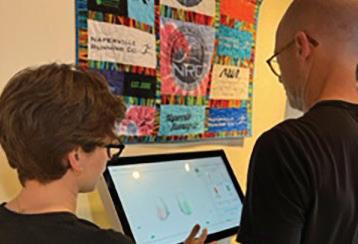
Comments provided by Marisa Hird, Apparel Buyer and Director of Culture and Marketing
We believe it’s important to keep up with the times. If a customer can go to Walmart and get their foot scanned, they better be able to walk into our shop and at least be offered something better. Our process delivers something other experiences don’t — a deep knowledge of the foot and a passion to help people.
You can buy our products anywhere, so it’s imperative that we make sure customers want to come back because of our service level. When someone leaves saying, “I haven’t received that type of service in years… or ever!” it’s the biggest compliment we could ever receive.
What do we call a success?
It’s when our customers leave with a smile on their face after an experience they weren’t expecting — and after having made a connection with an employee.
Technology is not necessary to fit someone for the right type of shoes, but it absolutely takes things up a notch. Our fit experience includes talking with customers followed by a visual analysis and Brannock measurements. Then we use the FootBalance 3D scanner and, if the customer is interested, we make custom insoles with molding heaters. The scanner helps us look more in depth at the shape and flexibility of the customer’s feet and offers us perspectives we can’t see during a visual test.
Our custom-molded insole option takes about four minutes from start to finish. We put the insole in the heater, after which
we help the customer place their feet on the insoles. Hopefully they feel great. If not, the customer is not obligated to purchase them. This enhances the customer’s in-store experience and hopefully inspires them to come back rather than making subsequent purchases online.
Tech’s Future: The future of tech in our industry is exciting to think about. Surely today’s technology will continue to improve. We’re already seeing some brands working on custom-made shoes based on scans. Hopefully future tech and data will improve our in-store efficiency which, when coupled with our knowledgable staff, will create customer loyalty.
Ultimately it’s our people who make run specialty special. Technology may elevate the fit experience, but our employees are the foundation. We don’t just sell shoes — we educate, inspire, connect, and motivate.
Two Locations: Oklahoma City & Edmond, OK Established 2010
Mission Statement: Red Coyote Running and Fitness was founded to actively promote a healthy lifestyle in Oklahoma City and surrounding communities. We strive to create an unprecedented customer experience by providing excellent customer care, unmatched product knowledge and building strong relationships.
Fitting Tech Used: Volumental Scanner, Woodway Treadmill, Brannock Device, Video Analysis, Currex Heat Map
Comments provided by Josh Lacan, Director of Training and Cultur e
The best fit happens when we meet and exceed the customer’s needs. Our goal is to always go the extra mile — we get the customer in the correct shoes for their specific activity, then help them find accessories and apparel. We also search for ways to get customers to be a part of our running community.
Technology is a big part of making this happen. Innovation is one of our core values and we are always looking for tech that best serves customers’ needs. The technology we use helps us see our customer’s foot anatomy, foot strike and previous injuries in a way that ensures the fit is customized to meet each customer’s unique requirements.
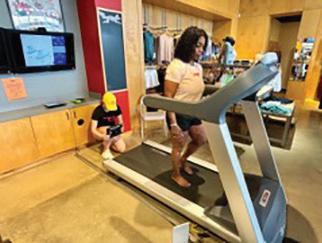
For every fit we use the Volumental Scanner. It shows us the customer’s foot in great detail and helps us find the perfect shoe. We look at foot length, width, arch height, instep height and heel width.
While our customers walk/ run on the rubberized Woodway Treadmill surface, we use iPads to record videos of their gait in slow motion. This gives us a better look at their rate of pronation. We play it back on our wall-mounted TV so the customer can easily see what we see. We also use a Currex Heat Map to get a better look at the customer’s arch in order to determine which insoles will work best for them.
As great as technology is, it isn’t foolproof. We still put every customer on a Brannock to double check the Volumental’s results. All the components we use offer a great opportunity to educate customers on shoes, insoles, socks and injury prevention tools that are most relevant. Technology is imperative. It takes the guesswork out of the process. No longer do we have to
say, “Believe me, this will help!” Now we leverage hard data and show the customer why a particular product makes sense. This combination of human and technological expertise builds trust, which leads to a deeper connection. Customers are wowed and excited to come back.
Tech’s Future: As technology continues to evolve, it’s likely we’ll be able to custom make, on-site, the perfect shoe for a customer. We embrace this possibility because it still brings the customer to our store, allowing us to make an essential human connection with them.
Our fit process will continue to change as run specialty matures. Surely our fitting process will morph to meet future needs. Perhaps everything will be done on an iPad without ever leaving the fit bench — the 3D scan, gait analysis, video, inventory inquiries, race sign ups and ringing out. Regardless, our Fit Coaches will always be shoe technology experts so they may smartly assess customers and create the necessary human connections.
Lafayette, LA
Established 2003
Mission Statement: The right shoe for what you do.
Fitting Tech Used: Brannock Device, Aetrex Scanner
Comments provided by Victoria LeBlanc, Social Media Manager and Sales Associate
for many different reasons. It doesn’t really matter whether their activity is running, working or just regular everyday use, our goal is to get them in the right shoe. Successfully doing this is marked by two main outcomes: The shoe feels great on their feet and every customer leaves feeling confident and informed about their footwear decision.
Technology is important to a successful fit because it’s able to show us things we can’t see with a naked eye. Specific foot length,

actual width, pressure points and more are more accurately defined when using technology that’s built to measure it.
The most crucial tool in our process is the Brannock Device. Its measurements allow us to learn the shape of the customer’s foot so we can match them with various categories, brands, and models. Our customers come in all the time wearing the wrong size shoes. The Brannock is enough to help them navigate their shoe fit with different sizes depending on brand.
We also us an Aetrex Scanner to capture the most accurate foot pressure data when the customer is standing and in-motion. The scanner creates a 3D model of the customer’s feet and displays it on the screen within seconds. It shows foot length and width measurement and even notes how the customer’s feet compare to an average person’s feet. Customers think it’s so cool.
Tech’s Future: The future will likely include technology to customize the customer’s entire shoe setup. There’s already tech that creates personalized inserts and builds shoes to match color preferences. Hopefully every brand will have custom coloring in the near future.
And though tech is great, machines cannot be as flexible as a fitter, nor can they offer an opinion. When a customer who measures for a size 10 prefers an 8, it’s the fitter who listens to the customer’s desires and makes the adjustment. The human touch is crucial.
Shoe fitting is a philosophy that caters to everyone’s story. A machine cannot compare to live, face-to-face customer service when it comes to a person’s unique needs.
22 Locations across four states: Massachusetts, Connecticut, New Hampshire, and Rhode Island
Established in 1975
Mission Statement: We believe in the freedom to move in the direction that aligns with your journey. Through trust, knowledge and a carefully curated product selection, we bring possibilities to life for our customers, our employees and our communities.
Tech Used: Aetrex Scanner
Comments provided by Avery Collard, Social Media & Community Marketing Coordinator
We believe a successful fit has two main components. First, the customer leaves with footwear that makes them feel fantastic. And second, the customer is taught about their specific foot and gait patterns that makes their movement more comfortable.
Technology is a crucial part of The Right Fit, our trademarked fitting process. It dates back to 1992 when we wanted to help customers navigate the sudden complexity of running footwear. Through the years we refined it by consulting with specialists – kinesiologists, physical therapists and orthopedists – and now this expert approach has become the foundation for all we do. A new employee takes an average of 200 hours to work their way through our training program, after which they can

execute fit at the highest level using visual/gait analysis and the Aetrex Scanner.
All customers are asked a series of questions that give us a better sense of their story. We then use the Aetrex Scanner’s pressure mapping and 3D imaging to quickly determine specialized information about their unique foot. The scanner notes hot spots, foot measurements, excessive pronation and more. It also makes a recommendation for a customized orthotic. We typically do a visual gait analysis to ensure the scanner didn’t miss anything.
We utilize these technologies to provide customers with the most thorough experience possible. With its assistance, we are able to get real-time biomechanical data so we can consistently pinpoint smart answers to pain issues and recommend relevant accessories.
People are regularly fascinated to learn something about their feet. Our technology is a
crucial tool in customer education and ensures we’re able to keep them deeply involved in their fit.
Tech’s Future: We imagine the future will include a similar sort of Aetrex Scanner, but perhaps with a moving platform on which the customer can run or walk. Since gait changes from standing to moving, having more detailed gait information would be a great help.
Technology will never compare to our staff’s real-world experience or passion for movement. It’s people, not tech, that are able to truly customize each customer’s particular solutions. A fitter’s ability to mentally flip through more than 150 pairs of shoes to find the one that fits just right is irreplaceable. Regardless of tech, people will be crucial to run specialty. While technology can be helpful, it can’t run a race, put on the shoes or relate to being injured. There will always be an important place for human beings in run specialty. n
Running Insight asks Lance Muzslay, CEO and co-founder of Optio, three questions on technology.
This Technology Issue of Running Insight features viewpoints from a number of retailers and vendors, all eager to provide advice on how technology can help change the game at run specialty retail. As part of this effort we reached out to someone intimately involved with technology and run specialty – Lance Muzslay, CEO and co-founder of technology provider Optio – for his insights into how and why retailers should embrace technology at their stores in 2024.
1. What advice do you have for retailers who are perhaps a bit hesitant to turn to new technology?
Good technology has the ability to supercharge your business and empower you to serve your customers better. It’s a good idea to talk to other stores who already use a particular technology under consideration. I find that stores are very happy to share their opinions and ideas with other stores. I believe that oftentimes the hesitation in adopting new technology is rooted in apprehension to embark on a learning curve.
Although it can be comfortable learning a new process, it’s important to see the big picture and focus on the efficiencies to be gained.
2. How would you rate run specialty in its progress in adopting new technology into their businesses?
As a whole I find that the channel has a big appetite for new technology adoption. Staff and resources are often spread thin and technology that empowers improved efficiency is highly appreciated. Once a store finds value in a new technology they enjoy spreading the word to other stores. The running channel has a nice sense of camaraderie and an attitude of sharing. That seems to stem from the same spirit which exists in the running community.
3. Finally, what do you feel is the future of retail technology in run specialty?
I see more and deeper integrations on the horizon. A beautiful thing about modern

software is its interconnectivity through APIs. Those APIs enable creative solutions that are greater than the sum of their parts.
For example, integrating B2B availability data with your store’s inventory on the same page so that you can quickly and efficiently compose purchase orders without having to jump back and forth is a huge time saver. I also foresee more opportunities to crowdsource data between stores so that emerging product trends and best practices can be shared to everyone’s benefit. n
Optio is a suite of software that optimizes buying and inventory management as well as enhances and fills feature gaps in point-of-sale systems. It strikes a balance between automating tedious and laborious tasks while allowing for quick and efficient decision making. Essentially, Optio integrates all relevant inventory and sales data in real time and delivers it in an easy to use and actionable manner for the task at hand. Think of it as the last mile in going from POS data to buying decisions.
The top part of the screenshot at left exemplifies combining current inventory, model stock values and past sales grouped by style and size (women’s Mizuno Inspire in this case). This enables buying decisions to be quickly made. The bottom part shows the PO compose window in which you can see on-hand inventory and B2B available quantities by color. After composing a PO it can be quickly imported into your POS as well as uploaded to the B2B site.


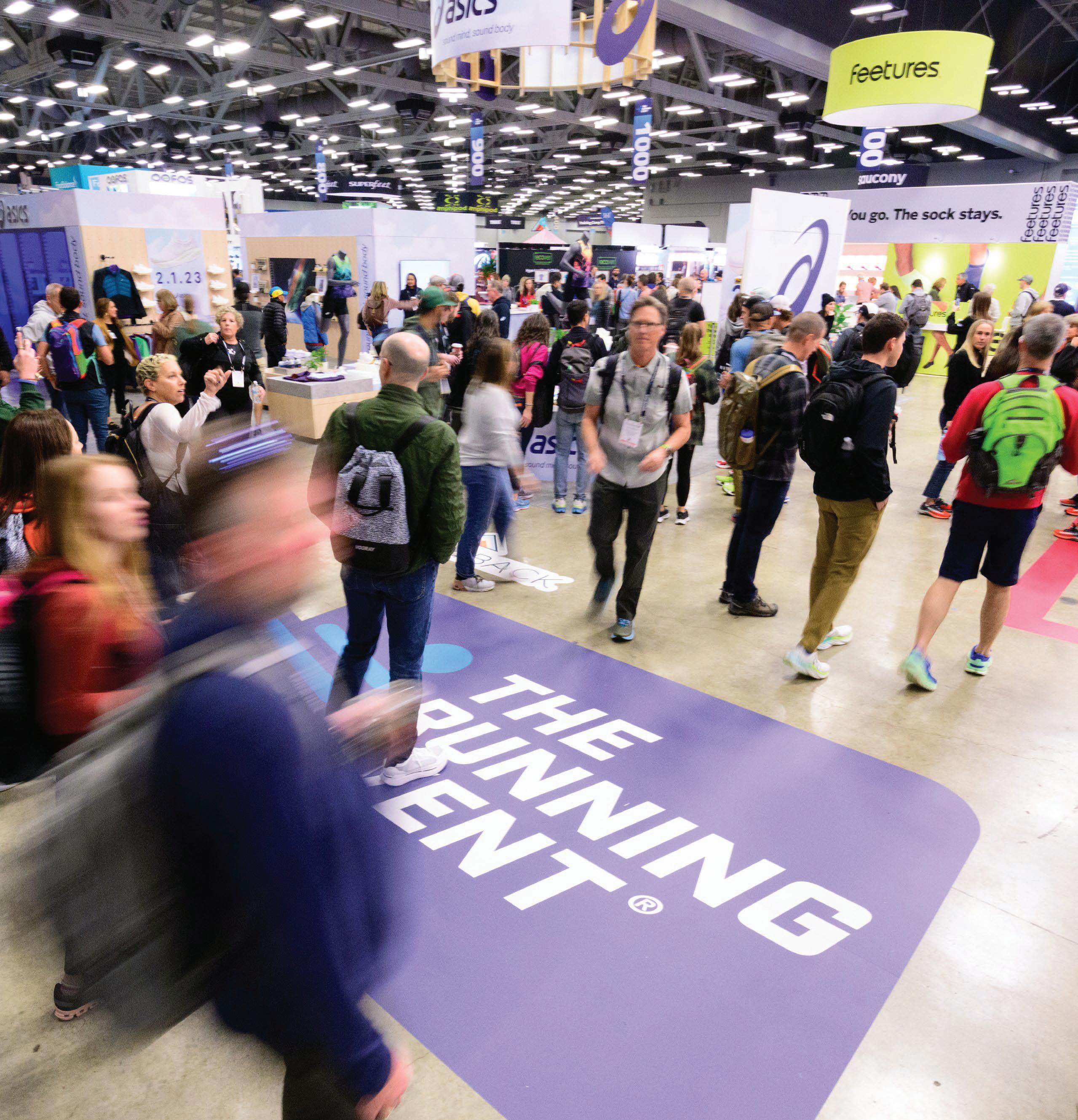
Like many of my colleagues, as an owner/operator in running specialty I wanted to learn how Generative AI could be integrated into our business. Along the way, I gained a deeper understanding of how it will impact us all.
I’m not part of the tech world. Like most of you, my day-to-day revolves around the age-old practice of specialty retail, which, according to Claude (one of the Chat Bots I use) “likely dates back thousands of years to ancient civilizations.”
I’m no Luddite, but with an iPhone 12 and a modestly powered Windows laptop, nobody will confuse me for a technophile, which makes me an unlikely candidate to share my perspective on the journey I’ve taken the past 18 months with Generative AI. But it also makes me an ideal candidate as I offer a very relatable perspective and am proof that a lot can be gained with just a little intellectual curiosity.
As an unlikely candidate to be drawn into this world, I should provide a little context. I’m fascinated by science and, several years ago, was captivated by the world of AI through the wonder of the podcast. Until last year. It was in 2023 that AI became “real,” and I had the opportunity to be more than an outside observer.
Was I going to experiment with these new tools? Absolutely.
The journey has been everything one would expect — exhilarating, frustrating, confusing and satisfying. And, yes, I’ve picked up some new skills, but, mostly, I have better clarity as to how we will need to adapt in the age of AI.
If I were to lump this clarity into one overarching statement it would be that, for most of us, effectively using these tools will require a different approach to problem solving.

But first a little more detail might be a lot more useful, so here are my three biggest takeaways from my journey so far.
Whether we realize it or not, Generative AI has given most of us a huge new skill set. Need to communicate more effectively? Analyze the results from a social media campaign? Interpret the legalese of a lease? Present POS data in a more useful manner? Develop novel ideas for store events? Or even write code to automate recurring reporting processes (English, after all, is “the hottest new coding language”)?
What was once beyond reach may now be within reach.
But acquiring these skills overnight does not mean I know what to do with them. I may no longer need to learn the skill, but I need to learn how to apply it. This should not be underestimated.
AI can be human-like in this way. Ask a vanilla question and you’ll get a vanilla answer. But if you really want the best answers or if you’re trying to unravel a complex task, asking precise and creative questions, or even having a Chat Bot suggest
which questions to ask (an oddly circular, but effective approach), is necessary.
And adding a sense of importance or appeal to emotion can help too. While demonstrating a use case for Generative AI I posed a question to a Chat Bot and included in my question that it was a live presentation and I wanted it to “show everyone how smart you are.” It gave a much better answer with this additional appeal than it had originally given without the appeal (research has shown this approach to be effective).
Cracking the code to get the best answers out of AI is a skill to be learned.
3. Today’s Struggle Can Be Tomorrow’s Solution
The speed at which these tools are progressing is impressive.
Ideas and use cases that seem impossible today may become reality soon. These tools are new and even their creators are still exploring their full capabilities and limitations.
And it occurs to me that, as an industry, we have the opportunity to accelerate our collective learning curve through collaboration. The progress we make as individuals is nothing compared to the progress we can make collectively. This opportunity beckons and it is my hope to help enable us, as an industry, to make the most of it.
So, what does all this mean?
As I see it, most of us are under-equipped for the world that awaits. To bridge this gap requires practice. And whether or not you have a strong interest or reason to begin using
Generative AI, this is the most compelling argument for starting to experiment with it. Many Generative AI tools are free to use and don’t require any skill beyond curiosity and patience. Start with something small (perhaps a poem celebrating the joys of running?), scale as you desire and, most importantly, enjoy the journey. It’s an amazing time to be alive. n
Steve DeMoss is the owner/operator of Big Peach Alpharetta and East Cobb. He has worked in running specialty for nearly 20 years and is currently the GM of Big Peach Running Co.’s East Cobb store (among other roles). He’s also the Small Business Thought Leader on the AI Insiders Discord Server.

AI can be humanlike in this way. Ask a vanilla question and you’ll get a vanilla answer. But if you really want the best answers or if you’re trying to unravel a complex task, asking precise and creative questions, or even having a Chat Bot suggest which questions to ask (an oddly circular, but effective approach), is necessary.
The new CEO at FootBalance speaks out on the role of technology in run specialty and how he plans to promote it.
Technology provider FootBalance recently appointed Atul Midha as chief executive officer. Midha joins FootBalance following senior leadership roles at companies such as Eton Shirts, Giorgio Armani and a number of fashion retail and tech startups, where he successfully drove growth and operational excellence.
Running Insight recently reached out to Midha to provide more insight into his plans for run specialty
First, tell us a little bit about yourself — an “elevator pitch” on Atul Midha, both personally and career.
I grew up in the retail industry, as a young kid in my mother’s fabric store in Oslo. I started mopping the floors and worked my way up to the cash register and eventually sales and customer service. Her work ethic was exemplary.
During my career, I’ve been fortunate to live and work on three different continents, which has given me a global consumer mindset. I grew up in Scandinavia and developed my career in New York and parts of Asia, where I lived for almost 20 years working in the retail business. The kids are in school in Oslo, Norway, but North America will always be our second home.
How about your professional career?
My professional background is strongly rooted in retail business. Before joining FootBalance I held senior leadership roles in renowned fashion retail companies and tech startups where I have a proven track record in successfully driving growth, operational excellence and
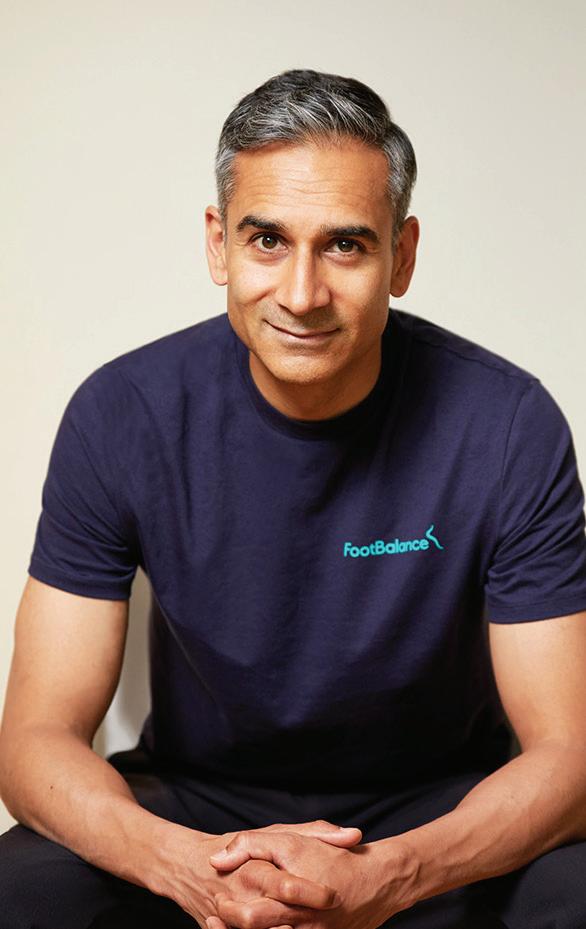
business transformation towards a more customer-centric approach.
Are you a runner?
I am a sports enthusiast and engage in sports in my free time. Most of my business metaphors are sports related. Even though my background is in fashion retail, it has always been my dream to work in the sports business. Now even better, with a meaningful company like FootBalance that improves people’s lives.
What is your running routine?
I am a very competitive person, always running with a stopwatch, trying to beat my own times. In my head, I still think I am 20-years old. On the other hand,
running is meditative for me. It’s my way to take a mental break from a busy workday and recharge my batteries.
What brought you to FootBalance?
My journey is quite interesting as it started before I joined FootBalance. Running is my way to get away from the busy workday. However, I started experiencing knee discomfort a few years ago and was unable to run any more. Then I discovered FootBalance. Thanks to its products I avoided surgery and recovered from my knee injury. But don’t challenge me to a race quite yet.
What do you think your previous business experience brings to your current position?
I am used to working in the ever-fastmoving fashion industry, where product shelf life is three months before markdowns. Understanding the importance of fast and agile go-to-market strategies to achieve a competitive advantage is crucial. I have a strong retailer mindset, predominantly in DTC business, where it is imperative to put the end consumer at the center of our strategy and decision making. I am fully convinced of the importance of an elevated consumer experience and the need for personalized services.
What similarities and differences do you see between FootBalance and your previous companies?
FootBalance, like my former company, has a strong focus on delivering first-in-class, high-quality products. At FootBalance, we are 100 percent foot health nerds. We believe that wellbeing begins at your feet and then runs
through your whole body. Pun intended.
What about the consumer aspect of the business?
FootBalance and my former companies are all very consumer centric. Our aim is to provide world-class service to our target audience, both retailers and end-consumers.
What do you see as the biggest challenges for you personally now at FootBalance?
Getting people to understand the importance of preventative foot health is one of our biggest challenges. We believe that your feet are the foundation of your body. You don’t often think about foot health until you start experiencing aches and pains. We want people to challenge themselves and not their feet.
How do you accomplish that?
We are thinking outside the box and finding ways to get consumers on a scanner. It’s completely free for the consumer. The process from 3D foot scanning to biomechanical analysis and custom insole molding takes only a few minutes and the health benefits are huge. The role of the running specialty store staff is vital and we need to get them excited about our technology and custom products.
What are the biggest opportunities?
Given that 75 percent of the population suffers from foot misalignment and there are eight billion feet in the world,
the opportunity is huge. Our time is now, especially since we know that consumer spending on personal health is growing and will grow for many years.
What is your favorite part of your new position?
It’s not so much the position but more about the company. We are in over 40 countries, touching almost 2000 points of sales. That is so exciting, but we have a lot of work to do. It is a very competitive space, and we have to be consistent, determined and willing to work for it.
How would you describe your management philosophy?
I love to play the role of a coach, challenge my team and help them reach their best. Team spirit is crucial to any success.
What is your goal for FootBalance in the U.S. run specialty business?
The goal is to keep runners active, fit and injury-free with our health technology and custom products. With our healthcare expertise, we support retailers in the best possible way to be forerunners in the foot health technology space. Naturally, I would love FootBalance to become a household name in the run specialty business. We have amazing partners and business on the West Coast, but need a larger presence on the East Coast.
What would be your message to run specialty retailers on why and how they should be open to adopting new technology for their stores?
Having worked over 25 years in the brick-andmortar retail business, I have witnessed how the digital evolution has changed shopping habits and how physical stores have had to adapt to ever-changing consumer needs. Post-pandemic, we see a resurgence of physical retail, with consumers demanding experiences, expert service, and personalization supported by technology and products.
What does that mean for run retailers?
FootBalance’s 3D foot scanning technology and custom products help retailers elevate the in-store experience to the next level. The technology is easy and intuitive to use, transforming store staff into authentic footwear

and foot health experts. For retailers, this means enhanced customer experience, more revenue streams, fewer returns, higher conversion, better profit margins, increased customer loyalty and, more importantly happy, healthy consumers. It is a clear win-win.
What do you think is unique and interesting about the U.S. run specialty business?
I am surprised by how many influential smaller run specialty retailers there are in the U.S. market. These retailers are not only respected by the bigger players, but also very well connected with local running communities.
Will we see you at The Running Event in Austin, Texas in November? Yes, of course! We will be there stronger than ever before and we have big news for the running industry. We recently won the 2024 Sport Technology Awards in the medical category. In addition, we have selected TRE24 as the place to launch our new ground-breaking technology. It’s going to be amazing! I am very excited to meet and greet the run specialty retailers, brands, and other industry professionals in Texas.
Finally, what do you want to accomplish at FootBalance headed into 2025 and what is it going to take to get there?
People make the company. I am hoping to build a strong team of passionate team members. n
These are not your father’s GPS watches.
No, the technology has advanced a long way since back in 2003 when Garmin introduced the Forerunner 201 to much acclaim and curiosity. The world’s first GPS running watch, the Forerunner 201 addressed runners’ desires for objective data like distance, time and pace on their run.
Never mind the Forerunner 201 was a bulky, flip phonesized personal computer for one’s wrist that suffered from satellite glitches and a comparatively high price tag of $160 (about the price of two pairs of the Nike Pegasus at the time). It was revolutionary and opened the floodgates to innovation in a nascent category.
Over the last two decades, GPS watches from the likes of Garmin, Coros, Suunto and others have become smaller, lighter, more reliable and robust, tracking not only mileage but also metrics like heart rate and sleep. They boast vibrant, high-resolution displays and expansive performance and lifestyle capabilities ranging from zone training to offline maps to music controls.
The evolution of GPS watches has created an attractive sales opportunity for run specialty shops, though one many have struggled to capitalize on given the category’s expense, the fast

pace of innovation and the category’s slower inventory turn.
But make no mistake: GPS watches deliver a compelling sales opportunity, contends Dan Suher, head of Americas for Suunto.
“Take a look at the wrists of customers coming through your doors and you’ll see many are wearing a GPSenabled device, so they’re buying these devices somewhere,” Suher says.
So, here’s the question: How can run shops earn more sales in this high-value category? To this, Suher, who spent four years at Coros before joining Suunto last year, has some battletested suggestions:
1. Listen and observe.
Many running retailers liken the sit-and-fit experience with footwear to an interview. It’s a chance to learn about customers and offer solutions to energize their fitness journey. While some customers might explicitly ask about tracking their mileage, others might drop subtle clues. Perhaps they travel a lot for work or are nervous about getting lost on trails, two situations in which they might appreciate learning about GPS watches and their capabilities.

So, too, can an associate gather clues from observation and following up with questions. For example, maybe a customer is wearing an older GPS watch. Ask them about their experience with the watch, what they like and what they wish it could do, like connecting to music or training guidance. More conversation generates rapport with the customer, but also creates a window to discuss relevant solutions.
“We can’t just wait for a person to come in and ask, ‘Do you guys sell GPS watches?’ and then jump out of our seat to make a $500 sale,” Suher says. “That mindset needs to be long, long gone.”
2. Create demo opportunities.
Given the high price points GPS watches carry, consumers are understandably hesitant to dive right into a purchase. Run shops can ease concerns and
provide interested customers a literal test run with the product by having demo models handy.
Shops can have watches available at group runs for trial or even create a loaner program where individuals can rent a watch for, say, $25 a week and then receive a credit in that amount should they purchase a new watch.
“These devices are so complex that you can read a manual front to back or watch DC Rainmaker talk about something, but until you actually use it yourself, you’re just never going to get the full flavor,” Suher says.
3. Introduce and inform.
Suher touts the value of retailers hosting consumer-facing clinics sharing information and insights on GPS watches and optimizing their use. With all the features and capabilities today’s GPS watches offer, a 45-minute program from a local coach or vendor rep on leveraging a watch
to enhance training and recovery can be incredibly valuable.
“These are the reasons why somebody shops with their local running shop instead of online or the big-box store,” Suher says.
4. Offer multiple solutions.
Suher acknowledges the constraints of a specialty retailer, especially when it comes to tying up thousands of dollars of inventory on slower-to-sell items. Still, he urges balance when it comes to stocking GPS watches and – as best and strategically as one can – stocking “a reasonable selection and reasonable diversity of product.”
“Take a look at the wrists of customers coming through your doors and you’ll see many are wearing a GPSenabled device, so they’re buying these devices somewhere.”
Dan Suher, Suunto
5. Take the long view.
Rarely will a GPS watch be an impulse buy. More likely, it’s something a consumer contemplates and researches over time. As such, multiple touchpoints with the consumer – an in-store clinic, a demo model and conversations with staff – help position a retailer to earn the sale.
“It’s so important to manage expectations,” Suher says. “You can’t do an event or a demo run and immediately determine its success by the number of watches you sold because it’s rarely going to be that direct. It’s likely one of multiple research points for the customer. And then, when they’re ready to make their purchase, they know, ‘Hey, this is where I’m going to get education and advice and support.’” n
“You don’t have to have every single watch from every single brand, but you should assess what your customers are gravitating towards? What are they looking for? How can you create different price points and different value?” Suher says. “If they can’t look at different brands and styles at their local store, then it’s more likely they’re going to purchase elsewhere.”
The success of On’s spray-on running shoes marks a whole new advance in run footwear technology.
This Technology Issue of Running Insight would be remiss if it did not end with perhaps one of the most remarkable shoe technologies coming down the road — spray-on running shoes!
The incredible technology was highlighted in a recent report by CNN’s Leah Dolan on Swiss running and sportswear brand On and its Olympic-timed introduction of advanced “spray-on” materials with a “revolutionary” robot-made sneaker it believes can improve performance at this month’s Games in Paris.
The shoe is called the Cloudboom Strike LS and it is described as “lace-free, weighs less than the latest iPhone and comes out of a pressurized can.” Priced at $330, the shoes were worn by Kenyan runner Hellen Obiri during her win at this year’s Boston Marathon. She wore them again to compete in Paris this month.
The shoes feature a complete 3D-printed sock-fit laceless upper and a blended 3D-printed midsole infused with Helion hyperfoam, derived from Pebax, ensuring bounce and energy return. Nestled within this cutting-edge construction is a fulllength carbon plate, providing propulsion and power.
On credits its shoes’ success to a combination of biomechanics, physiology and extreme lightness. (A men’s U.S. size 8.5 weighs just 170g per shoe, over 100g lighter than several popular running shoes of the same size.)
“More than anything, we want (the athletes) to win,” On senior director of innovation, Ilmarin Heitz, said in a recent promotional video. “That is our gauge of success.”
With no heel-cap, laces or tongue, the translucent, sock-like sneaker looks like

a running shoe that has shed its skin. According to the CNN report, its inventor, Johannes Voelchert, came up with the idea as a student after seeing a Halloweenthemed hot glue gun that shot decorative spider webs.
“I saw that there was a quick way of creating a textile onto a complex shape,” Voelchert, now On’s senior lead of innovation concept design, said in the brand’s video. “A shoe seemed to be the right object.”
Voelchert brought his idea to the Milan Design Fair, where CNN says he caught

the Swiss sportswear brand’s attention. According to On, the shoe’s uppers are made from a type of thermoplastic and colored and branded in three minutes using just a robotic arm. The upper is sprayed in one step and can be attached to the carbon-fiber and foam rubber sole using heat, not glue.
The company claims its technology reduces the carbon emissions of producing a shoe’s upper by 75 percent, compared to its other sneaker models. The material, which it dubs LightSpray, has “the potential… to move us towards a more sustainable, circular future,” said Marc Maurer, On’s co-CEO, in a press release.
For now, the Cloudboom Strike LS will be made-to-order — a production model On hopes will generate less waste. Having initially been made available to the public in April, the shoes will again go on sale to consumers later this year. n